a) Java: The Complete Reference
b) HeadFirst: Servlets and JSP
Chapter 1: Why use Servlets and JSPs
Chapter 2: Web App Architecture
Chapter 3: Mini MVC Tutorial
Chapter 4: Request and Response - Being a Servlet
Chapter 5: Attributes and Listeners - Being a Servlet
Chapter 6: Session Management - Conversational State
Chapter 7: Using JSP - Being a JSP
Chapter 8: Scriptless JSP - Script-free pages
c) Servlet and JSP : A Tutorial Kurniawan, Budi
- At a basic level, JavaBeans are simply Java classes which adhere to certain coding conventions. Specifically, classes that have:
publicdefault (no argument) constructors- allow access to their properties using accessor (getter and setter) methods
- implement
java.io.Serializable - all JavaBean instance variables should be private
- A POJO (plain-old-Java-object) isn't rigorously defined. It's a Java object that doesn't have a requirement to implement a particular interface or derive from a particular base class, or make use of particular annotations in order to be compatible with a given framework, and can be any arbitrary (often relatively simple) Java object.
- All JavaBeans are POJOs but not all POJOs are JavaBeans.
- Note that Spring beans need not always be JavaBeans. Spring beans might not implement the
java.io.Serializable interface, can have arguments in their constructors, etc.
This is the very basic difference between JavaBeans and Spring beans.
- The reason Spring managed objects are referred to as beans is because in the very early versions, Spring was intended only for use with JavaBeans. That is no longer the case of course: Spring can manage just about any object, even if it doesn’t have JavaBean type characteristics such as default constructors or mutator methods (getters and setters). None the less, the term ‘Spring beans’ has stuck. Can Spring beans be POJOs? Yes, and they usually are (although they don’t have to be – e.g. Spring can be used with ‘heavyweight’ Java objects, such as EJBs). Can Spring beans be JavaBeans? As I have said, yes and again they often are but don’t have to be.
- Entity Beans:
- Stateful Session Beans
- Stateless Session Beans
- Singleton Beans
Session beans represent logic while entity beans represented persistent objects. These days entity beans aren't used anymore in favour to JPA entities.
There are two ways in which the developer of a Bean can indicate which of its properties, events, and methods should be exposed. With the first method, simple naming conventions are used. These allow the introspection mechanisms to infer information about a Bean. In the second way, an additional class that extends the
BeanInfo interface is provided that explicitly supplies this information.
The introspection mechanism finds all of the public methods of a Bean. Protected and private methods are not presented.
- Simple:
A simple property has a single value. It can be identified by the following design patterns, where
Nis the name of the property andTis its type:
public T getN()
public void setN(T arg)
A read/write property has both of these methods to access its values. A read-only property has only a get method. A write-only property has only a set method. - Indexed:
An indexed property consists of multiple values. It can be identified by the following design
patterns, where
Nis the name of the property andTis its type:
public T getN(int index);
public void setN(int index, T value);
public T[] getN();
public void setN(T values[]);
T
is the type of the event:
public void addTListener(TListener eventListener)
public void addTListener(TListener eventListener) throws java.util.TooManyListenersException
public void removeTListener(TListener eventListener)
These methods are used to add or remove a listener for the specified event. The version of
addTListener() that does not throw an exception can be used to multicast an event, which
means that more than one listener can register for the event notification. The version that throws TooManyListenersException
unicasts the event, which means that the number of listeners can be restricted to one. In either
case, removeTListener() is used to remove the listener.
//TODO: Example code of how to actually use a listener to listen for an event and take action based on it.
| Interface | Description |
|---|---|
| Servlet | Declares the life cycle methods for a Servlet |
| ServletConfig | Allows Servlets to get intiialization parameters |
| ServletContext | Enables servlets to log events and access information about their environment |
| ServletRequest | Used to read data froma Client Request |
| Servlet Response | Used to write data to a Client Response |
| Class | Description |
|---|---|
| GenericServlet | Implements the Servlet and the ServletConfig interfaces |
| ServletInputStream | Encapsulates an input stream for reading requests from a client |
| ServletOutputStream | Encapsulates an output stream for writing response to a Client |
| ServletException | Indicates a Servlet error occurred |
| UnavailableException | Indicates a Servlet is Unavailable |
- A servlet is a small Java program that runs within a Web server. Servlets receive and respond to requests from Web clients, usually across HTTP, the HyperText Transfer Protocol.
- To implement this interface, you can write a generic servlet that extends
javax.servlet.GenericServlet
or an
HTTP servlet that extends javax.servlet.http.HttpServlet.
- This interface defines methods to initialize a servlet, to service requests, and to remove a servlet from the server. These are known as life-cycle methods and are called in the following sequence:
1) The servlet is constructed, then initialized with the init method.
2) Any calls from clients to the service method are handled.
3) The servlet is taken out of service, then destroyed with the destroy method, then garbage collected and finalized.
- In addition to the life-cycle methods, this interface provides the
getServletConfig method,
which the
servlet can use to get any startup information, and the getServletInfo method, which allows the
servlet to
return basic information about itself, such as author, version, and copyright.
| Method | Description |
|---|---|
| void init(ServletConfig sc) throws ServletException | Called when the Servlet is initialized. Initialization parameters for the Servlet can be obtained from the sc. A ServletExce[tion should be thrown if the Servlet cannot be intiialized |
| void service(ServletRequest req, ServletResponse res) throws ServletException, IOException | Called to process a request from the Client. The request from the clint can be read from req, the response to the client can be written to res. An exception is generated if if a servlet or IO problem occurs. |
| void destroy() | Called when the Servlet is unloaded from the memory |
| String getServletInfo() | Returns a String describing the Servlet |
| ServletConfig getServletConfig() | Returns a ServletConfig object that contains any initialization parameters |
ServletContext object is contained within the ServletConfig object, which
the Web server provides the servlet when the servlet is initialized.
- This interface defines a set of methods that a servlet uses to communicate with its servlet container, for example, to get the MIME type of a file, dispatch requests, or write to a log file.
- There is one context per "web application" per Java Virtual Machine. (A "web application" is a collection of servlets and content installed under a specific subset of the server's URL namespace such as /catalog and possibly installed via a .war file.
- The servlet container creates a ServletRequest object and passes it as an argument to the servlet's service method.
- A ServletRequest object provides data including parameter name and values, attributes, and an input stream. Interfaces that extend
ServletRequest can provide additional protocol-specific data (for
example, HTTP data
is provided by HttpServletRequest.
- The servlet container creates a
ServletResponse object and passes it as an argument to the
servlet's service method.
- To send binary data in a MIME body response, use the
ServletOutputStream returned by getOutputStream().
To send character data, use the PrintWriter object returned by getWriter(). To mix
binary and text data, for example, to create a multipart response, use a ServletOutputStream
and manage the character sections manually.
HttpServlet instead.
-
GenericServlet implements the Servlet and ServletConfig interfaces.
.
javax.servlet.http.
| Interface | Description |
|---|---|
| HttpServletRequest | Extends the ServletRequest interface to enable servlets to read data from the HTTP
Request
|
| HttpServletResponse | Extends the ServletResponse interface to enable servlets to write data to an HTTP
response
|
| HttpSession | Provides a way to identify a user across more than one page request or visit to a Web site and to store information about that user. |
| Class | Description |
|---|---|
| Cookie | Allows state information to be stored ona Client machine |
| HttpServlet | Provides methods to handle HTTP requests and responses. |
ServletRequest interface to provide request information for HTTP servlets.
- The servlet container creates an
HttpServletRequest object and passes it as an argument to
the servlet's service methods (doGet, doPost, etc).
- Java EE Link to the methods
ServletResponse interface to provide HTTP-specific functionality in sending a
response. For example, it has methods to access HTTP headers and cookies.
- The servlet container creates an
HttpServletResponse object and passes it as an argument to
the servlet's service methods (doGet, doPost, etc).
- Several constants are defined that correspond to the different status codes that can be assigned to a HTTP Response.
- Java EE Link to the methods
- The servlet container uses this interface to create a session between an HTTP client and an HTTP server. The session persists for a specified time period, across more than one connection or page request from the user. A session usually corresponds to one user, who may visit a site many times. The server can maintain a session in many ways such as using cookies or rewriting URLs.
- This interface allows servlets to:
- View and manipulate information about a session, such as the session identifier, creation time, and last accessed time
- Bind objects to sessions, allowing user information to persist across multiple user connections
- When an application stores an object in or removes an object from a session, the session checks whether the object implements
HttpSessionBindingListener. If it does, the servlet notifies the object
that it has
been bound to or unbound from the session. Notifications are sent after the binding methods complete. For
session that are invalidated or expire, notifications are sent after the session has been invalidated or
expired.
- When container migrates a session between VMs in a distributed container setting, all session attributes implementing the
HttpSessionActivationListener interface are notified.
- A servlet should be able to handle cases in which the client does not choose to join a session, such as when cookies are intentionally turned off. Until the client joins the session,
isNew returns
true. If the client chooses not to join the session, getSession will return a different session
on each request, and isNew will always return true.
- Session information is scoped only to the current web application (
ServletContext), so
information stored in one context will not be directly visible in another.
- Java EE Link to the methods
- Cookies are valuable for tracking user activities. For example, assume that a user visits an online store. A cookie can save the user's name, address, and other information. The user does not need to enter this data each time he or she visits the store.
- A servlet can write a cookie to a user's machine via the
addCookie() method of the HttpServletResponse
interface. The data for that cookie is then included in the header of the HTTP response that is sent to the
browser. The names and values of cookies are stored on the user's machine.
- Some of the information that can be saved for each cookie includes the following:
- The name of the cookie
- The value of the cookie
- The expiration date of the cookie
- The domain and path of the cookie
- The domain and path of the cookie determine when it is included in the header of an HTTP request. If the user enters a URL whose domain and path match these values, the cookie is then supplied to the web server. Otherwise, it is not.
- Java EE Link to the methods
HttpServlet class extends GenericServlet. It is commonly used when
developing servlets that receive and process HTTP requests.
- Provides an abstract class to be subclassed to create an HTTP servlet suitable for a Web site. A subclass of
HttpServlet must override at least one method, usually one of these:
doGet, if the servlet supports HTTP GET requestsdoPost, for HTTP POST requestsdoPut, for HTTP PUT requestsdoDelete, for HTTP DELETE requestsinitanddestroy, to manage resources that are held for the life of the servletgetServletInfo, which the servlet uses to provide information about itself
service method. service handles standard HTTP
requests by dispatching them to the handler methods for each HTTP request type (the doXXX methods listed
above).
Likewise, there's almost no reason to override the doOptions and doTrace methods.
- Servlets typically run on multi-threaded servers, so be aware that a servlet must handle concurrent requests and be careful to synchronize access to shared resources. Shared resources include in-memory data such as instance or class variables and external objects such as files, database connections, and network connections.
- Java EE Link to the methods
- A session can be created via the
getSession() method of HttpServletRequest. An
HttpSession object is returned. This object can store a set of bindings that associate names
with objects. The setAttribute(),
getAttribute(), getAttributeNames(), and removeAttribute() methods of
HttpSession manage these bindings. Session state is shared by all servlets that are associated
with a client.
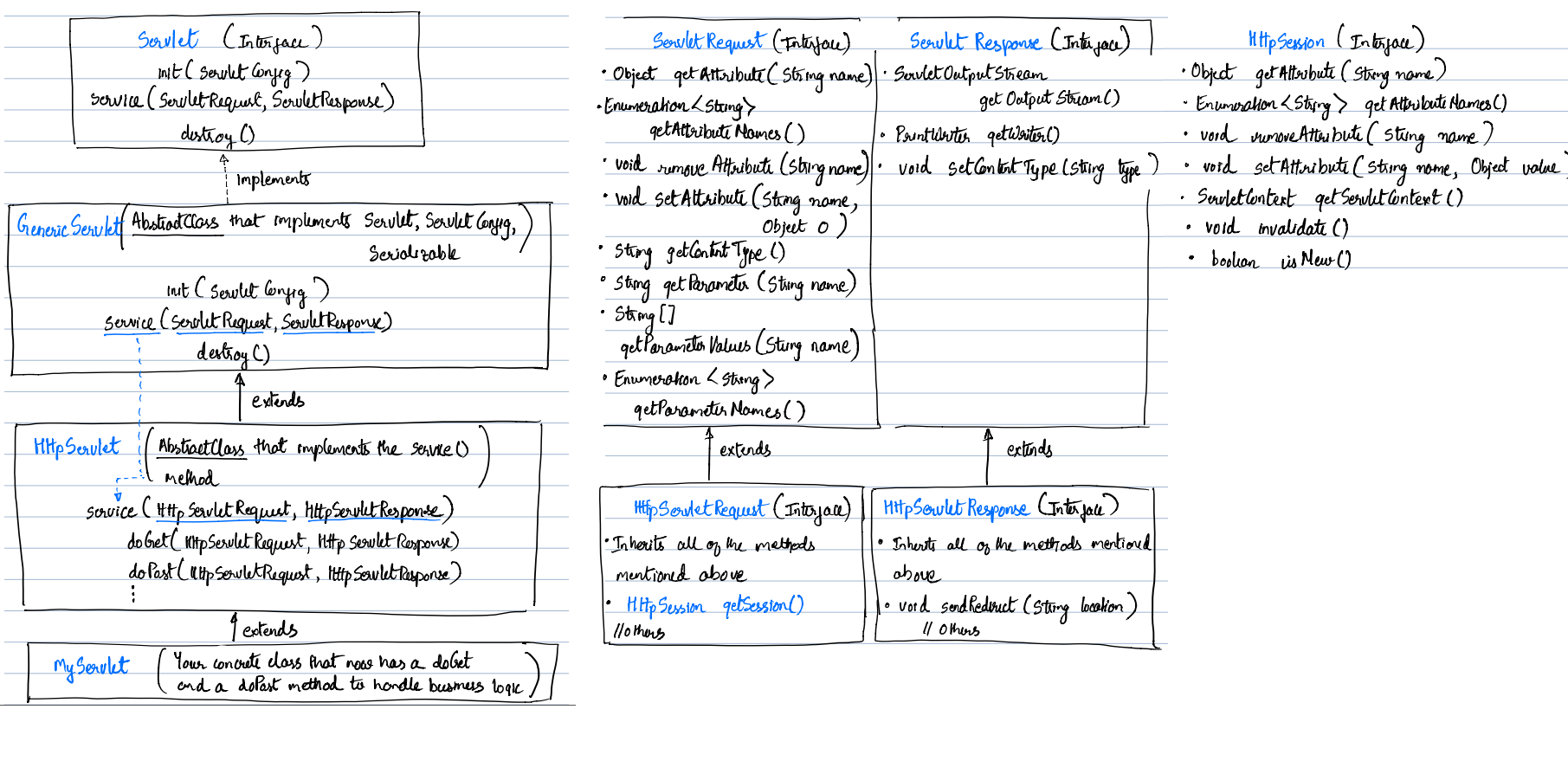
Web Server
: A web browser lets a user request a resource. The web server receives the request, finds the resource, and then sends it back to the user. A resource can be anything - HTML page, image, PDF File. If the requested resource is not found, the server replies with a404-Not Found error code.
A web server can refer to either the physical machine (hardware) or the web server application
(software). Web Client
: Both the human and the browser application (Mozilla, Chrome) being used are referred to as the Web Client. A web browser can communicate with the web server. It can interpret the HTML code that is sent as a part of the server's response and render that web page. Hence a Web Client (browser) lets the user request something from the server and shows the user the result of that request.HTML
: When a server answers a request, the server usually sends some type of content for the browser to display. This content is written in HTML. Two important tags in HTML are:form and input HTTP
: Most of the conversations held on the web between clients and servers are held using HTTP Protocol, which allows for simple request-response type conversations. The client sends anHTTP Request and the Server responds with a HTTP Response.
HTTP runs on top of TCP/IP. The structure of and HTTP conversation is a simple Request/Response.
HTTP protocol has several methods, but we mostly use GET and
POST
methods.
GET: Gets a resource (HTML page, image, file,..) from the server and sends it back to the Client. You can also send some data (from the Client to the Server) with aGETrequest, but this is not recommended. Firstly, because the number of characters that are sent via aGETrequest are limited and secondly all the data sent in aGETrequest is visible in the URL. The "?" separates the path and the parameters. Together, the entire String is the request that is the URL that is sent with the request.POST: With POST, you can request something and at the same time send form data to the server. For eg., if the user has completed a long form, you want this data to be stored into a database. In this case you would use aPOSTmethod. The data to be sent back to the server is known as the "payload" or the "message body".
<html></html> that the client then renders as the HTML page that we finally see.
index.html by default.
- Think of a port as a logical connection to a particular piece of software that is running on the server hardware.
- There are a bunch of other ports that are pre-defined to connect to specific services. The TCP ports from 0 to 1023 are reserved for well-known services. Don't use these ports for your own custom programs.
PrintWriter.println()
method. The HTML code that is to be returned to the web server is included as a String type
argument in the println() method. As you can hope, stuffing properly formatted HTML tags
into
the println()is not a viable solution. For eg. you will have to manually escape every quote
character (") because Java treats them as end of string character. And HTML happens to use a ton of
quotes
to specify the attribute values and what not.
- To solve this problem, JSPs were introduced. This allows us to add Java code to HTML instead of writing HTML code in a Java class. The JSP page contains java variables that calls the main Java code and creates the completed HTML page as a JIT web page.
- Read more about what a servlet is on SO here. A servlet is simply a class which responds to a particular type of network request - most commonly an HTTP request. Basically servlets are usually used to implement web applications - but there are also various frameworks which operate on top of servlets (e.g. Struts) to give a higher-level abstraction than the "here's an HTTP request, write to this HTTP response" level which servlets provide. Servlets run in a servlet container which handles the networking side (e.g. parsing an HTTP request, connection handling etc). One of the best-known open source servlet containers is Tomcat.
main() method. They are under the control of another Java application
known as the Container.
- Apache is you web server application. Tomcat is your Container.
- When your web server application gets a request for a
Servlet (as opposed to, say, a plain static HTML page) the server hands the
request not to the servlet itself, but to the Container in which the servlet is deployed.
- It's the Container that gives the Servlet the HTTP Request and Response, and it's the Container that calls the servlet's methods like
doGet() and doPost().
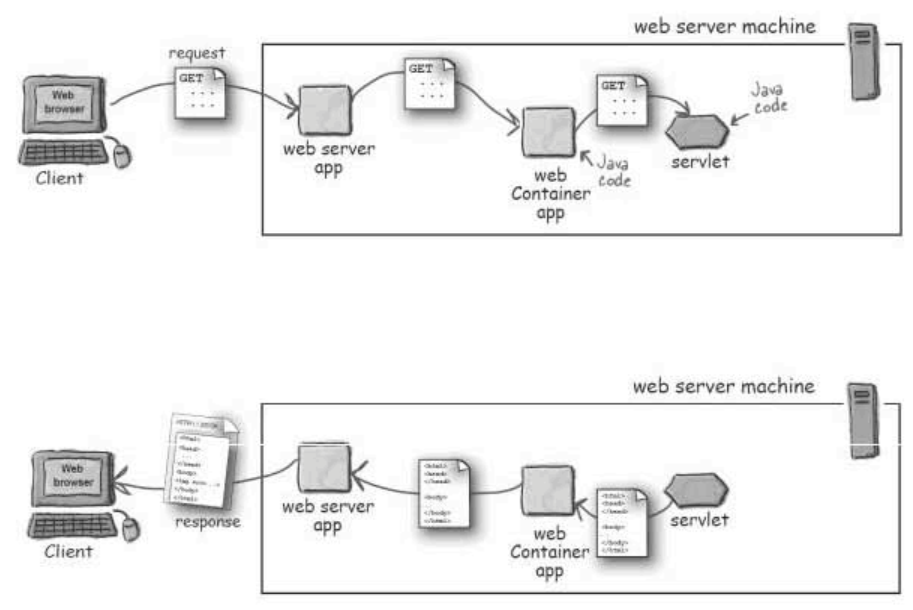
Communication Support
: The Container(Tomcat) provides an easy way for your Servlets to talk to your Web Server. You don't have to build a ServerSocket, listen on a port, create Streams, etc. The Container knows the protocol between the Web Server and itself, so that your Servlet does not have to worry about, say, the API between the Apache Web Server and your own web application code.Lifecycle Management:
The Container controls the life and death of you servlets. It takes control of loading the classes, instantiating and initializing the servlets, invoking the servlets methods, and making servlets instances available for garbage collection. With the Container in control, you do not have to worry about the resource management.Multithreading Support:
The Container automatically creates a new Java thread for every servlet request that it receives. When the Servlet's done running the HTTPservice()
method for that Client's request, the thread completes (dies). But you are still responsible for
Thread safety and other synchronization issues. It's just that the work involved in creating and
deleting threads is reduced.
Declarative Security:
XML Deployment Descriptors allow you to configure Security without having to hard-code it into any of your servlets or other classes.JSP Support:
Container also takes care of translating the JSP code into real Java.Step 1:
User clicks on a link that has a URL to a servlet instead of a static web page
Step 2:
The Container "sees" that the request is for a Servlet, so the container creates two objects:HttpServletRequest and
HttpServletResponse

Step 3:
The Container finds the correct Servlet based on the URL in the request, creates or allocates a thread for that request, and calls the servlet'sservice(HttpServletRequest req, HttpServletResponse resp) method, passing the request and
response objects as arguments .

Step 4:
Depending on the type of the request, theservice() methods calls either the doGet() or
doPost() methods. For this example, we assume that the request was a HTTP GET method. So the
service() method calls the servlet's
doGet(HttpServletRequest req, HttpServletResponse resp) method passing the request and the
response objects as arguments.

Step 5:
ThedoGet() method generates the dynamic page and stuffs
the page into the
response object. Remember that the Container still has a reference to the Response object.

Step 6:
The thread completes, so the thread either dies or returns to a Container-managed thread pool. The container converts the response object into an HTTP Response, sends it back to the client, and then deletes the request and the response object.
Ch2Servlet) does not have a main()
method. It only has a doGet() method. In the below example, we are basically overriding the
doGet method of the HttpServlet class.
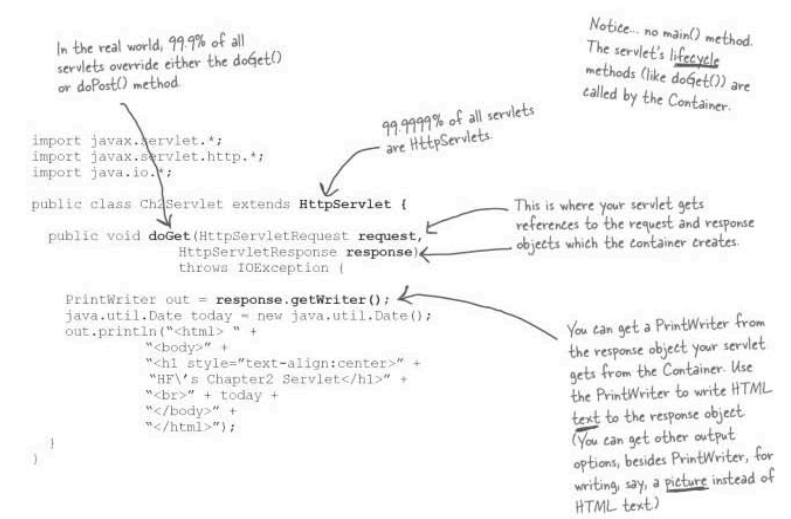
HttpServlet is an abstract class that to be subclassed to create an HTTP servlet
suitable for a Web site. A subclass of HttpServlet must override at least one method, usually one of these:
doGet, if the servlet supports HTTP GET requestsdoPost, for HTTP POST requestsdoPut, for HTTP PUT requestsdoDelete, for HTTP DELETE requestsinit and destroy, to manage resources that are held for the life of the
servlet
getServletInfo, which the servlet uses to provide information about itselfservice method. service handles
standard HTTP requests by dispatching them to the handler methods for each HTTP request type (the doXXX
methods listed above). - Source for the below text.
- Servlet API classes reside in
javax.servlet and javax.servlet.http. - These packages are distributed with Tomcat. Tomcat is a open source servlet container and webserver.
- The javax.servlet package contains three interfaces:
a) Servlet - init(), service(), destroy()
b) ServletRequest
c) ServletResponse
- The
javax.servlet.http package supplies interfaces that make it easy to build servlets that
support HTTP requests and responses. Two important interfaces in javax.servlet.http are
HttpServletRequest and HttpServletResponse. - The
HttpServlet class extends GenericServlet and is used to develop servlets
that handle HTTP requests.
- Consider a compiled Servlet class that is present in the following directory:
classes/registration/SignUpServlet.class - The Servlet can be called using any of the following 3 names:
- Why do we do this:
- Flexibility: We can change the path of the .class file without breaking the path of every file that referenced this class file
- Security: We do not want the Client to know the internal directory structure of the Server.
Deployment Descriptor to tell the container how to run your Servlets and JSPs.
- We use two XML elements to map URLs to Servlets - one to map the Client-known Public URL Name to our own internal deployment name, and the other to map our own internal deployment name to the fully-qualified class-name.
//TODO:Where is the DD file stored in the IntelliJ project that we created? I am pretty sure it is just the
web.xml file in your project.
- The two DD elements for URL Mappings are:
<servlet>: maps internal name to fully-qualified class name<servlet-mapping>: maps internal name to public URL name
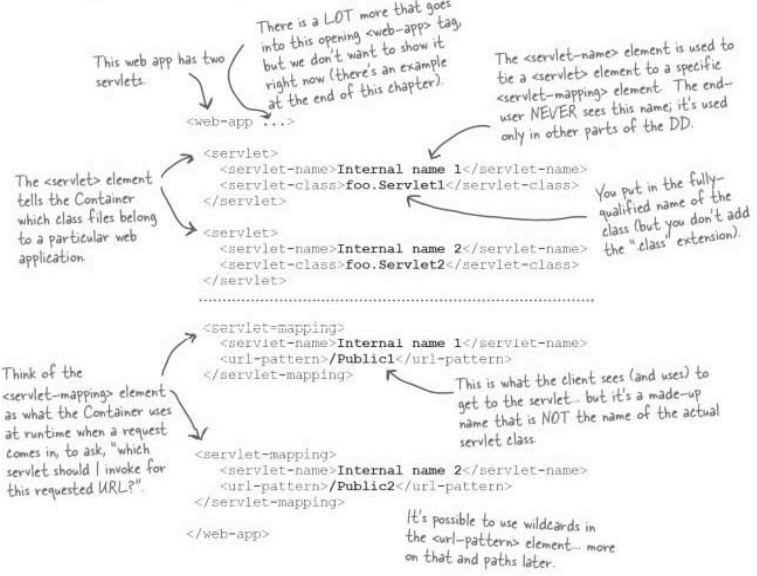
<servlet-class> tag still contains only the class name and not the complete
path of the the .class file. This is because the Container has a specific place that it will look for all
Servlets for which you have specified a mapping in the DD. - There is a lot of other stuff that you can do using the
web.xml file. Refer this Oracle link to see
which elements can be defined using your deployment descriptor.
- This is how the code looks without using MVC:
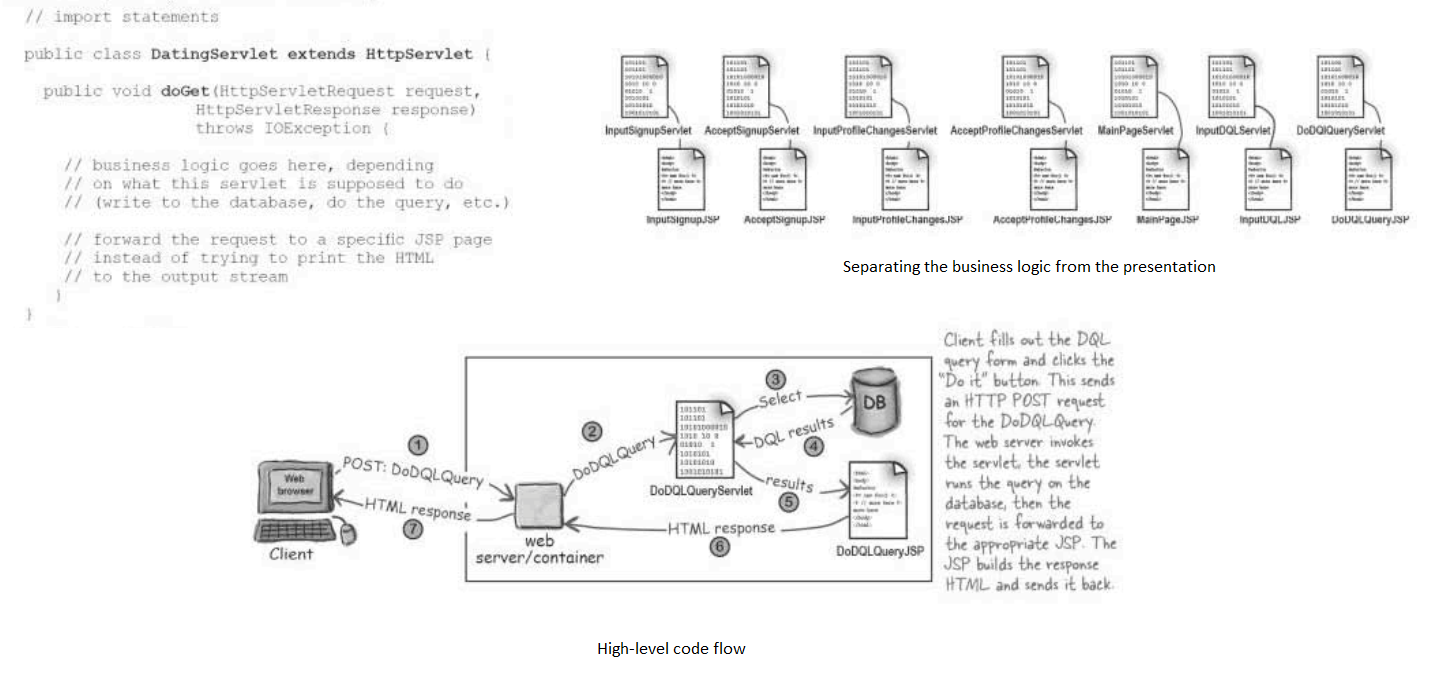

Model, a JSP
page that will be the View, and the original Servlet, bereft of any logic or HTML, that will
form
the Controller part of the puzzle.
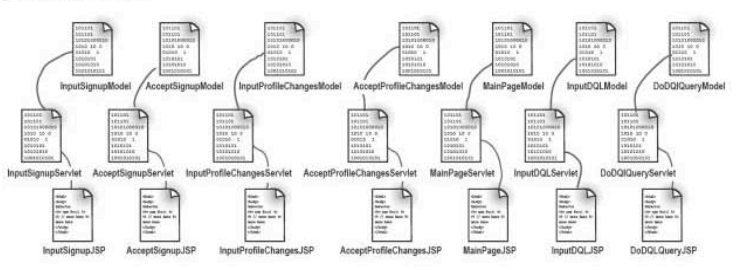

- A fully-compliant J2EE server must have both a web Container and an EJB Container (plus other things including a JNDI and JMS implementation). Tomcat is just a web Container!(?). It is still compliant with the portions of J2EE spec that address the web container. Tomcat is a web container, not a full J2EE application server, because Tomcat does not have an EJB Container.
- As shown in the below figure, a J2EE application server consists of both a web container and an EJB Container. Tomcat is a web Container but not a full J2EE Application server.
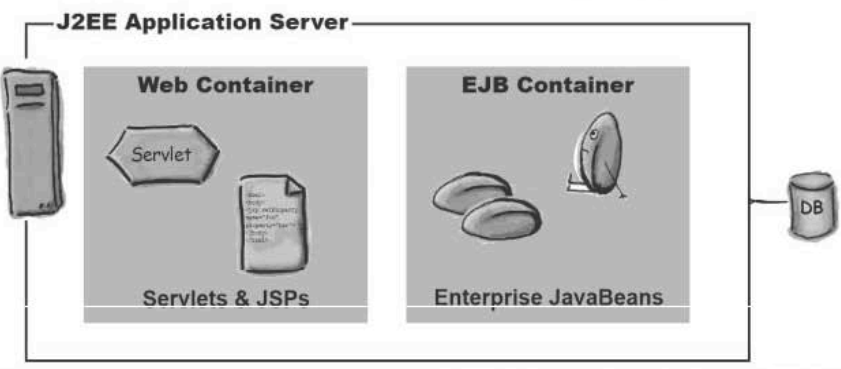
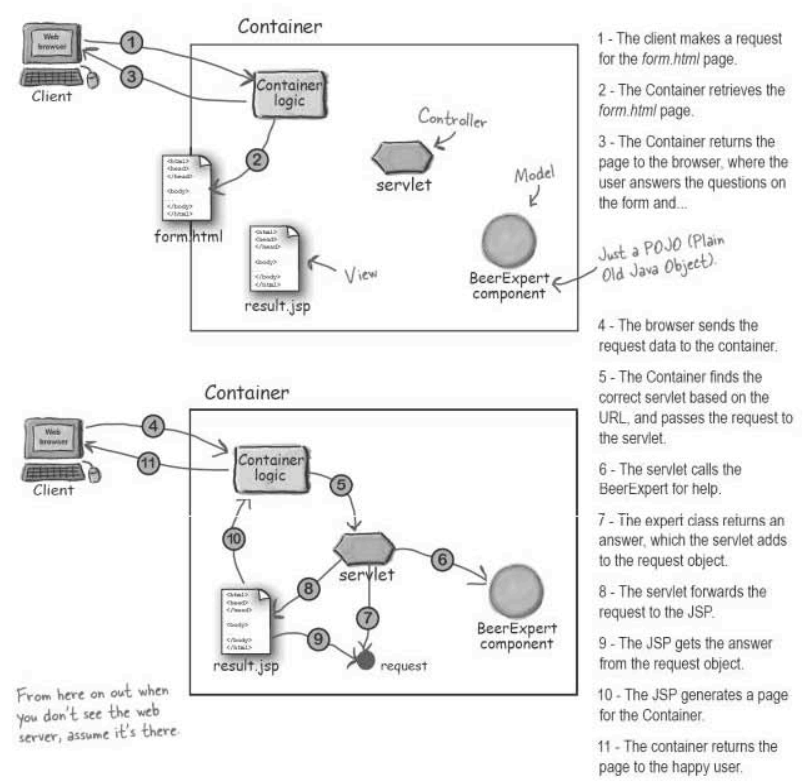
-index.jsp is the file that contains the first page that the user sees when they login into
the http://localhost:8080/BeerV2_war_exploded/. Changing the name of index.jsp
to some other name causes the app to stop working for some reason.
- The web.xml is the Deployment Descriptor that we looked at in the previous chapter. br
- When it's time to deploy our app, we will copy a portion of this into wherever our particular
Container wants the pieces to go.
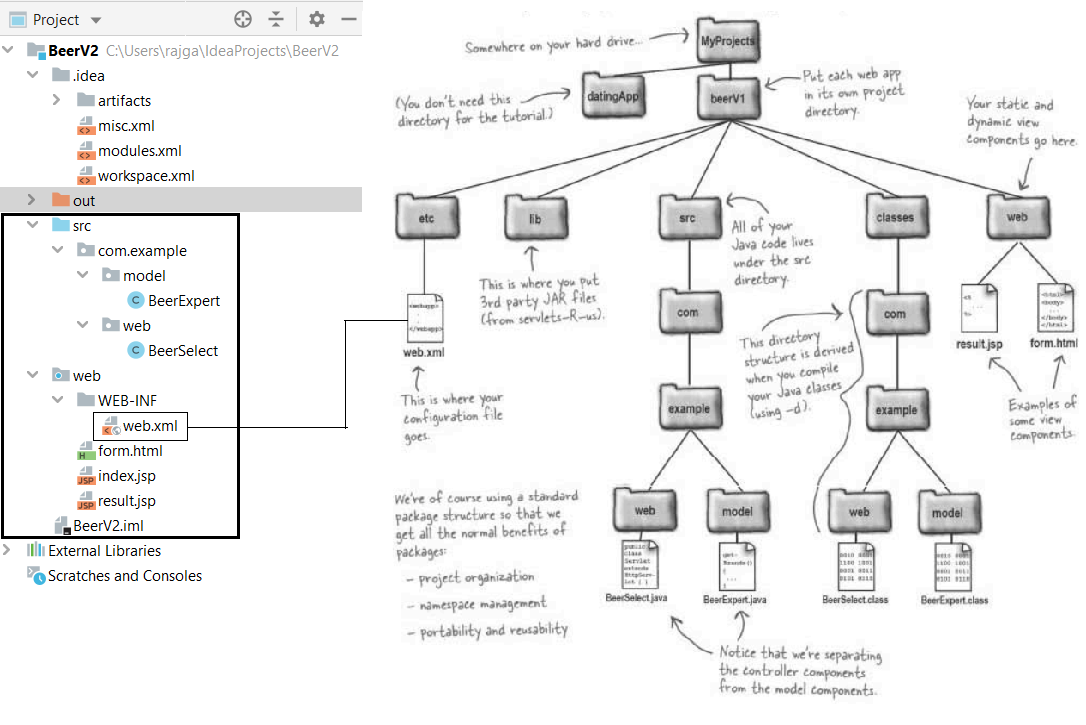
- Note that the Beer-v1 directory represents the context root which Tomcat uses when resolving URLs.
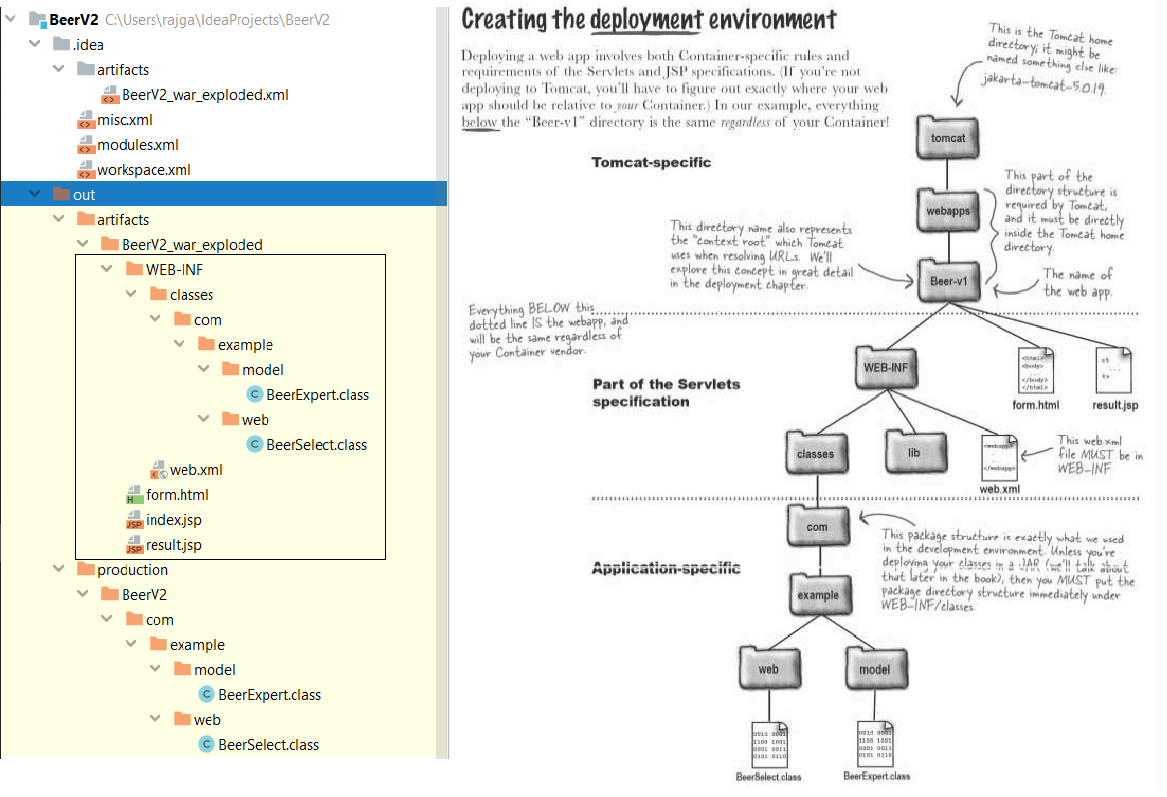
Step 1
: The Client makes a request for the form.html pageStep 2
: The Container retrieves the form.html pageStep 3
: The Container returns the page to the browser where the user answers the question on the form and Clicks Submit
POST request to the server. This
request is sent to the SelectBeer.do file (Line 20). Remember that there is no actual class
named such. It's mapped to an internal Servlet name using the Deployment Descriptors.
POST /BeerRecommender_war_exploded/SelectBeer.do. In the HTML, the /BeerRecommender_war_exploded/
isn't part of the path in the HTML, it just says:
<form method="POST" action="SelectBeer.do">
But the browser prepends the /BeerRecommender_war_exploded/ on to the request because that's
where the client request is coming from. In other words, the SelectBeer.do is relative to the
root of the web app /BeerRecommender_war_exploded


Step 4
: The browser sends the request data to the Container. Now the Container has to figure out which is the actual Class to which theSelectBeer.do maps.
- For this, the Container looks in the
web.xml file (Deployment Descriptor). The container
searches the DD and finds a <servlet-mapping> with a <url-pattern>
that matches /SelectBeer.do where the / represents the context root of the web
app, and SelectBeer.do is the logical name of the resource. - The container sees that the
<servlet-name> for this <url-pattern> is
'Ch3 Beer'. But that isn't the name of the actual servlet class file. To a container a servlet is something
that is named in the DD under the <servlet> tag. The 'name' of the servlet is simply
the name used in the DD so that other parts of the DD can map to it. - So now the container looks inside the
<servlet> tags for something with the
<servlet-name> 'Ch3 Beer'. - The Container uses the
<servlet-class> in the <servlet> tag to know
which servlet class is responsible for handling this request. If the servlet has not been initialised, the
class is laoded and the servlet is initialized. - The Container then starts a new thread to handle the request, and passes the request to the thread (to the servlet's
service() method).
Step 5
: The Container finds the correct Servlet and passes the request to the Servlet. This class acts as the Controller, calling the ModelBeerExpert for the business logic, and the View
result.jsp for the response.
Step 6
: The Servlet calls the BeerExpert class for help.Step 7
: The BeerExpert class returns an answer that the Servlet class adds to the request object.The Container provides a mechanism called "Request Dispatching" that allows one container-manged component to call another container-managed component. This is what we use here - the Servlet gets the info from the model, saves it in the request object, then dipatches the request to the JSP.
Step 8
: The Servlet forwards the request to the JSP.Step 9
: The JSP gets the answer from the request object.Step 10
: The JSP generates a page for the Container.Step 11
: The Container returns the page to the User.service() method, passing the request and response
objects references as arguments.
In this Chapter we look at the Servlet's life in more detail.
- The servlet lifecycle is pretty simple.. There is only one main state:
initialized. If the
servlet isn't initialized then it is either being initialized (by running it's constructor or the
init() method), being destroyed (by running it's destroy()) method, or it
simply does not exist. - A state diagram for the servlet would look something like this:
init, service, and destroy methods
do?
init()
-
service()
service() method to be invoked. This method
looks at the request, determines the HTTP method (GET, POST, etc.) and invokes the matching doGet()
or doPost() methods respectively. Note that there are other methods in HTTP as well (HEAD, PUT,
etc) and there are corresponding doXXXXX() methods for almost all of them. Refer the HttpServlet
class below. You should not override the service() method. Your job is to override the doGet()
or the doPost() methods, and let the service() implementation from the HttpServlet
worry about calling the right one.
-
doPost()/doGet()
service() method
invokes the doGet()
or the doPost() based on the HTTP method (GET, POST, and so on). This is where your code begins.
All the stuff that your app is supposed to be doing goes in here. Always override at least one of these methods.
Whichever ones you override tells the Container what you support. If you do not override doPost(),
for example, then you are telling the Container that this servlet does not support the HTTP POST request.
-
destroy()
service()
method again on the Servlet.
ServletContext
to get information from the Container. MyServlet class. The Container
calls MyServlet's init() method. But if I do not
override init, the one from GenericServlet runs. Then when a request comes in, the
Container starts or allocates a thread and calls the service() method, which I do not override. So
the service method from the HttpServlet runs. The HttpServlet service
method then calls my overridden doGet or doPost methods. So each time my
doGet or doPost runs, it's in a different thread.
- The Servlet inherits the following methods:
- You might hear things like "Each instance of the servlet..". This is incorrect. There aren't multiple instances of any servlet class (except SingleThreadModel, but that is a bad design pattern). The Container runs multiple threads to process multiple requests to a single servlet. And every Client request generates a new pair of request and response object.
thread-per-request vs thread-per-connection
: Per request means when an HTTP request is made, a thread is created or retrieved from a pool to serve it. One thread serves the whole request. Thread per connection would be the same thing except the thread is used for an entire connection, which could be multiple requests and could also have a lot of dead time in between requests. Servlet containers are thread per request. Source on SO.Should I spawn new threads in a JAVA EE Container
: If you're in a full Java EE container, threads may be managed for you in a way that makes it a bad idea to spawn your own. Source on SO. Also there are now Concurrency Utils that enable you to achieve this so that you do not have to do this manually. Source on SO.HttpServlet is in a different package from GenericServlet. How many servlet packages are there?
Everything related to servlets is in eitherjavax.servlet or
javax.servlet.http. It's easy to tell the difference because things that have to do with HTTP
are in the javax.servlet.http package whereas the generic servlet classes and interfaces are in
javax.servlet.
init() method. The init() method is
called just once during the entire life of the servlet. - A servlet allows you to access the following:
ServletConfig
: This controls the deploy-time values you've configured for the servlet (one per servlet). Things that your servlet might want to access that you do not want to hard code, like maybe a database name.ServletConfig parameters won't change for as
long as this servlet is deployed and running. To change them, you will have to re-deploy the servlet. This
is also used to access ServletContext. The parameters are configured in the Deployment
Descriptor. ServletContext
:There is only oneServletContext per web app, NOT
one per servlet. These are used to access web app parameters that are also configured in the Deployment
Descriptor.
HttpServletRequest methods are about HTTP things like cookies, headers, and sessions.
HttpServletRequest interface adds the methods that relate to the HTTP protocol. Same thing with
the HttpServletResponse as well. - ServletRequest: A ServletRequest object provides data including parameter name and values, attributes, and an input stream. Interfaces that extend ServletRequest can provide additional protocol-specific data (for example, HTTP data is provided by
HttpServletRequest). - ServletResponse: Defines an object to assist a servlet in sending a response to the client. The servlet container creates a ServletResponse object and passes it as an argument to the servlet's service method.
- HttpServletRequest: Extends the
ServletRequest interface to provide request information for HTTP servlets.
The servlet container creates an HttpServletRequest object and passes it as an argument to the servlet's
service methods (doGet, doPost, etc). - HttpServletResponse: Extends the
ServletResponse interface to provide HTTP-specific functionality in sending a
response. For example, it has methods to access HTTP headers and cookies.
The servlet container creates an HttpServletResponse object and passes it as an argument to the servlet's
service methods (doGet, doPost, etc). - Remember that
HttpServletRequest and HttpServletResponse are interfaces as well.
The implementation of these interfaces is left to the vendor. All you need to know is the methods that you
can call on these objects. The actual class does not matter because you are referring to the request and the
response objects only by the interface type.
- There are 8 HTTP methods (actually 9 now). There is no mechanism in the servlet API for handling
doConnect,
so it is not a part of the HttpServlet.
- Recall the difference between
GET and POST that we studied earlier. The key
difference between the two was
that POST has a body, whereas in the GET request all of the parameters are sent in the
header. Remember that GETis ONLY supposed to be getting things from the server. it should
not make any changes to the server. POST on the other hand is used to send data to the server for
update.
- This makes
GET an idempotent request: making the same GET request twice will
cause no negative consequences on the server.
-
POST, on the other hand, is a non-idempotent request. The data sent to the server could be
used to update some state that cannot be reversed. Think a financial transaction that cannot be reversed.
Intuitive example in book.
Basically, you want to ensure that your app logic can handle scenario where the same request comes in more than
once by mistake.
- Note that there is nothing stopping you from implementing the
GET method in the doGet
method as an non-idempotent method. But you would not want to do so...
color1. But what if we
wanted two or more parameters from the user. This is how we would do it:
color1=light,
in
this example the parameters will be sent as color1=light&theSize=heavy. That is - the POST
request will have both the parameters but separated by an ampersand.
- The Servlet class would then use the parameters in the following manner:
- In the previous example, you had one parameter
theSize associated with just a single value
(either light, medium, or heavy). However, some form inputs like checkboxes can have more than one value.
That means a single parameter like theSize will could have more than one value depending on how
many boxes the user has checked off. - This is what the form looks like:
userName=&userEmailId=&beer_color_user_likes=light&user-newsletter=on&user-beer-sizes=12&user-beer-sizes=14
- Assume on the front-end we selected the 12oz and 14oz checkboxes. In the below image you can see that beer_sizes in the servlet code contains the value associated with the checkboxes of 12oz and 14oz options.
- //TODO: Read up on the methods
getInputStream
and getReader.
If one is called, then the other can't be called or something like that.
- Note the presence of the three different methods:
getRemotePort:
In this case, since it is the server asking, it's the Client that is the
Remote. So getRemotePort means the Client's remote port. In other words, the
port number on the Client from which the request was sent. Remember, if you are a servlet, remote
means the Client.
getServerPort:
This method asks "to which port was the request originally sent"
getLocalPort:
This method asks "on which port did the request ultimately end up".
There is a difference between the above two methods because although the requests are sent to
a single port (where the server is listening), the server turns around and finds a different
local port for each thread so that the app can handle multiple clients at the same time.
- You call two methods on the response:
setContentType and getWriter. After that
you are simply doing I/O to write HTML (or something else) to the stream. But you can also use the
response to set other headers, send errors, and add cookies.
getResourceAsStream
method. Note that there is another method called getResourceAsStream in the Class
class
as
shown here on Java docs. Both are different from each other. - This SO Link goes into detail about ways to troubleshoot
getResourceAsStream causing a NPE. There
are a lot of linked questions on the page as well that should be helpful. - Answer by BalusC explaining different ways that you can access a file from your code. Do you understand what a 'classpath' actually means now?
- Note the path where we placed the file:
- Note the '/' inside the
url-pattern. Without that, we get an error saying invalid url.
setContentType do- Content types are included in HTTP responses because the same, byte for byte sequence of values in the content could be interpreted in more than one way. Remember that http can transport more than just HTML (js, css and images are examples), and in some cases, the receiver will not know what type of object it's going to receive. This is the same thing as setting the MIME type. Content type is an HTTP Header that must be included in the HTTP Response.
- Remember to always call
setContentType before you have called the method that gives you your
output stream (getWriter or getOutputStream). That will guarantee you will not run
into conflicts between the content type and the output stream.
- Common MIME types are:
- text/html
- application/pdf
- video/quicktime
- application/java
- image/jpeg
- application/jar
- application/octet-stream
- application/x-zip
ServletOutputStream and
PrintWriter:
- You can either use the
getWriter()
or you can use the getOutputStream()
setHeader and addHeader
methods
setHeader:
Sets a response header with the given name and value. If the header had already
been set, the new value overwrites the previous one. The containsHeader method can be used to test for the
presence of a header before setting its value. -
addHeader:
Adds an additional value to the response header. Added value being the the current given name and value.
This method allows response headers to have multiple values. - Along the same lines you have
addIntHeader
and setIntHeader.
- We will look at both the methods in the following examples.
- You need to specify a URL to redirect to. And you do it using
response.sendRedirect("/yourRedirectUrl") - The URL can be specified in different ways, by which I mean, you can either give the full path of the URL (like "https://www.google.com"), or you can give the Relative URL.
- Now the relative URL can be specified in two ways. Either the URL can or cannot start with a forward slash
/ character. - Imagine the client originally typed in
https://www.ws.com/myApp/cool/bar.do. The request comes in into the servlet mapped to bar.do,
and the servlet calls sendRedirect() with a RELATIVE URL that does NOT start with a '/':
sendRedirect("foo/stuff.html"). The container will then build the full URL relative to the
original request URL:
https://www.ws.com/myApp/cool/foo/stuff.html. Hence if you don't start with a '/', then the
request path is prepended to the front of foo/stuff.html - But if the argument to the
sendRequest() DOES start with a '/' as in
sendRedirect("/foo/stuff.html"), the container will build the complete URL relative to the WEB
CONTAINER ITSELF, instead of the original URL of the request. So the new URL will be:
https://www.ws.com/foo/stuff.html. foo is treated as a separate webapp from the
myApp webapp in the previous case. Hence, in this case, the forward slash at the beginning means
"relative to the root of this web container". 302 Found redirect- A response with
302 is a common way of performing URL redirection. Along with the
302 status code, the response should include a Location header with a different URI. Such
header will be parsed by the user agent and then perform the redirection:
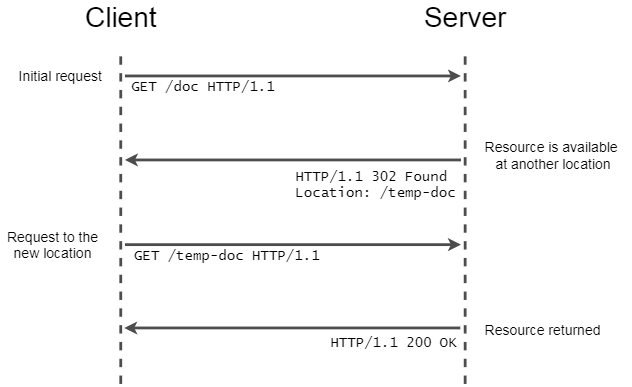
302 Found as follows: The 302 (Found) status code indicates that the target
resource resides temporarily under a different URI. Since the redirection might be altered on occasion, the
client ought to continue to use the effective request URI for future requests.
The server SHOULD generate a Location header field in the response containing a URI reference
for the different URI. The user agent MAY use the Location field value for automatic
redirection. The server's response payload usually contains a short hypertext note with a hyperlink to the
different URI(s).
Note: For historical reasons, a user agent MAY change the request method from POST to GET for the subsequent
request. If this behavior is undesired, the 307 (Temporary Redirect) status code can be used
instead. - On our page, the 302 behavior looks something like this:
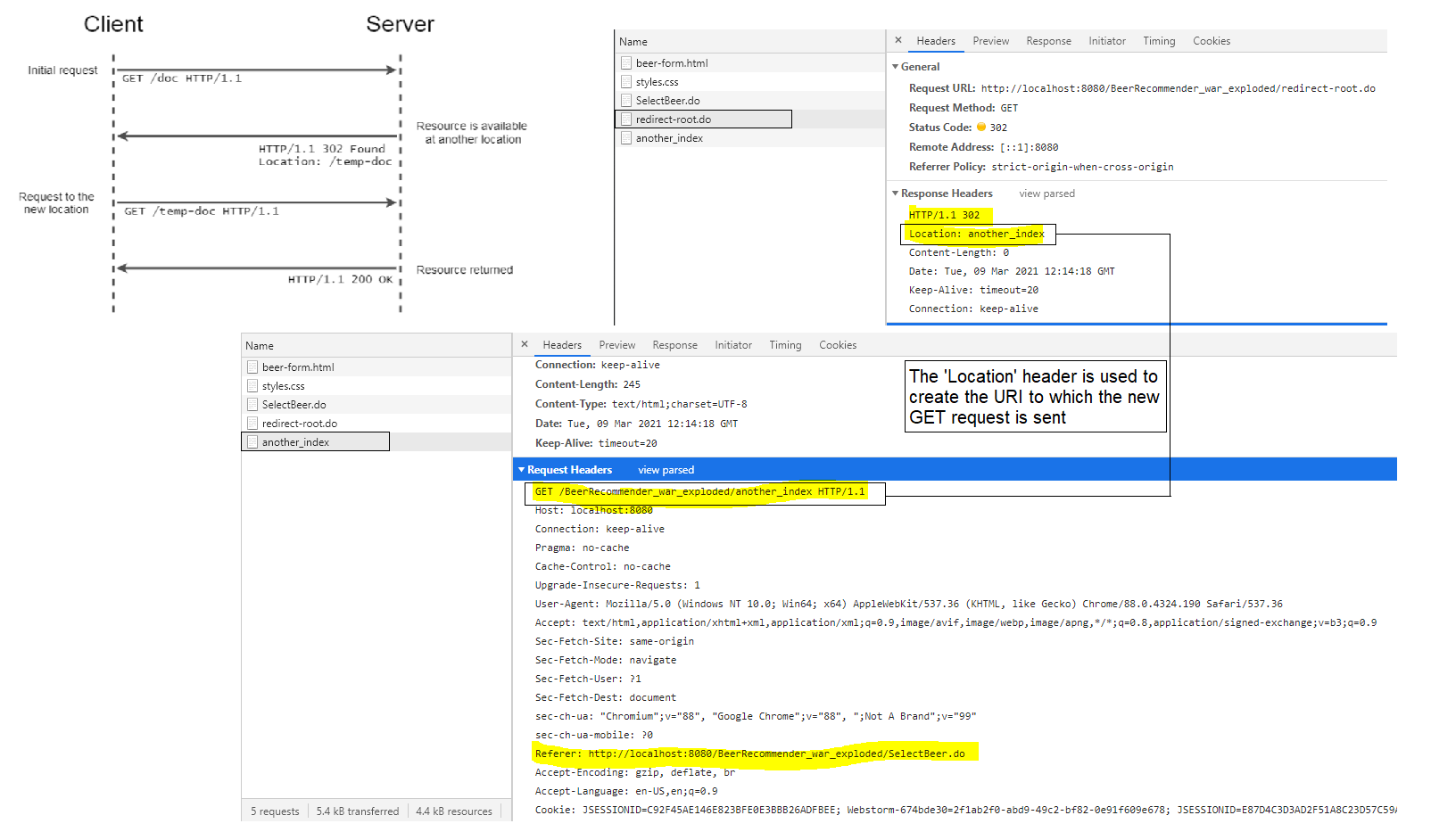
- Remember that you can set the headers manually as well. This is how we are achieving this.
WEB-INF folder. The problem with this is that, because the files are outside the
WEB-INF folder, we can directly access them by going to the URL directly. What I mean is, we
could directly type in
http://localhost:8080/BeerRecommender_war_exploded/beer-form.html in the address bar, and that
would take us to the form. No need to click on anything or to go through actual links. Now this is fine for
the form, but becomes a problem when we navigate to the result.jsp page directly by typing in
the address. It leads to 500 error because the request object is not populated yet. - So we want a structure that looks something like the below one:
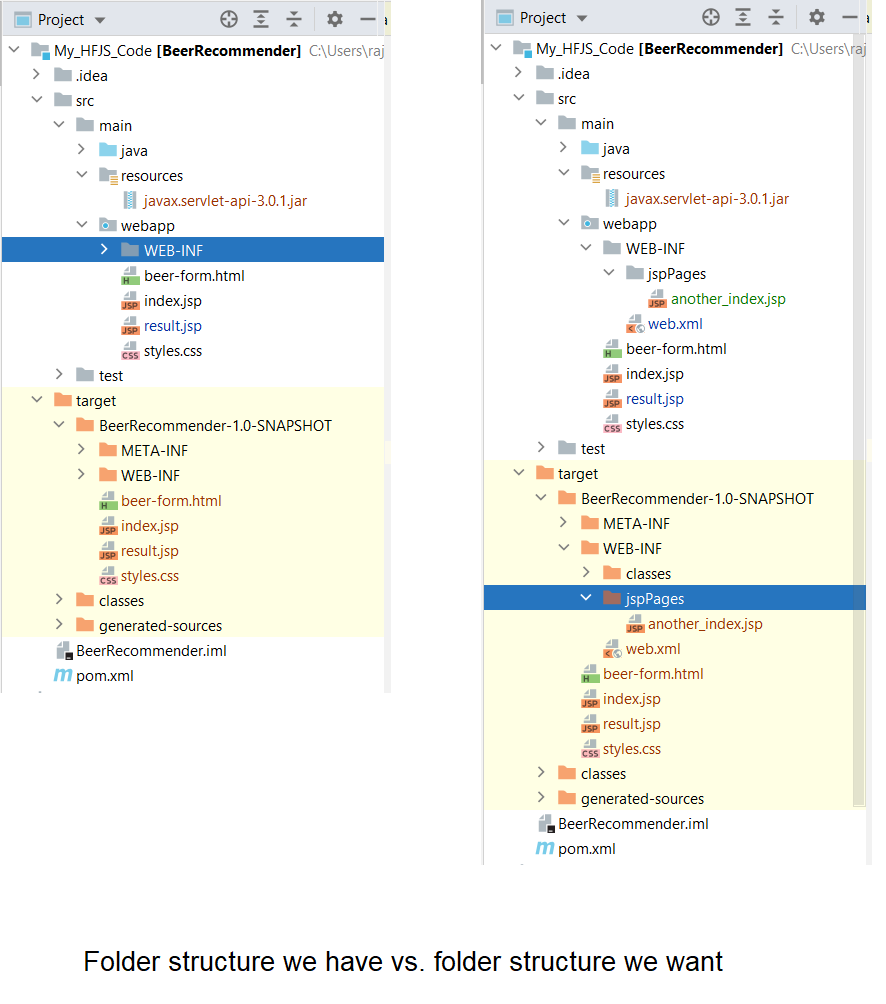
WEB-INF folder is a protected resource. It will have to be
accessed by calling /WEB-INF/ from a ServletContext. Source on
SO. - So how do we do this? Read this SO answer here. The left image is currently the scenario 1 in the answer. We want it to change to scenario 3.
${pageContext.request.contextPath}-
- Read about the differences between the two on SO here.
- //TODO: Write Code Example.
init-params in the
ServletConfig?
<init-param> element to specify
the name-value pairs. Note that the <init-param></init-param> should be inside the
servlet element that you want to initialize with the particular value.
- When the Container initializes a Servlet, it makes a unique
ServletConfig for the Servlet.
The Container reads the servlet init parameters from the DD and gives them to the ServletConfig,
and then passes the ServletConfig to the servlet's init method.
- Note that the Servlet init parameters are read only once - when the Container initializes the Servlet. Once the parameters are in the
ServletConfig they won't be read again until/unless you redeploy
the servlet.
context-params
in ServletContext?
- For accessing servlet-init/ServletConfig params :
getServletConfig().getInitParameter("emailId"); - For accessing context-init/ServletContext params:
getServletContext().getInitParameter("adminEmailId"))
- Both of these methods are from the
GenericServlet class that is inherited by the HttpServlet
which in turn is inherited by your Servlet class. -
ServletConfig is one per servlet, whereas ServletContext is one per webapp.
i.e. every servlet and JSP deployed as part of a single webapp has access to that same
ServletContext. But every servlet has it's own ServletConfig. - A servlet-init parameter and a context-init parameter can have the same name. Remember, they are being read from completely different objects. Hence there is no issue of shadowing/name space conflict.
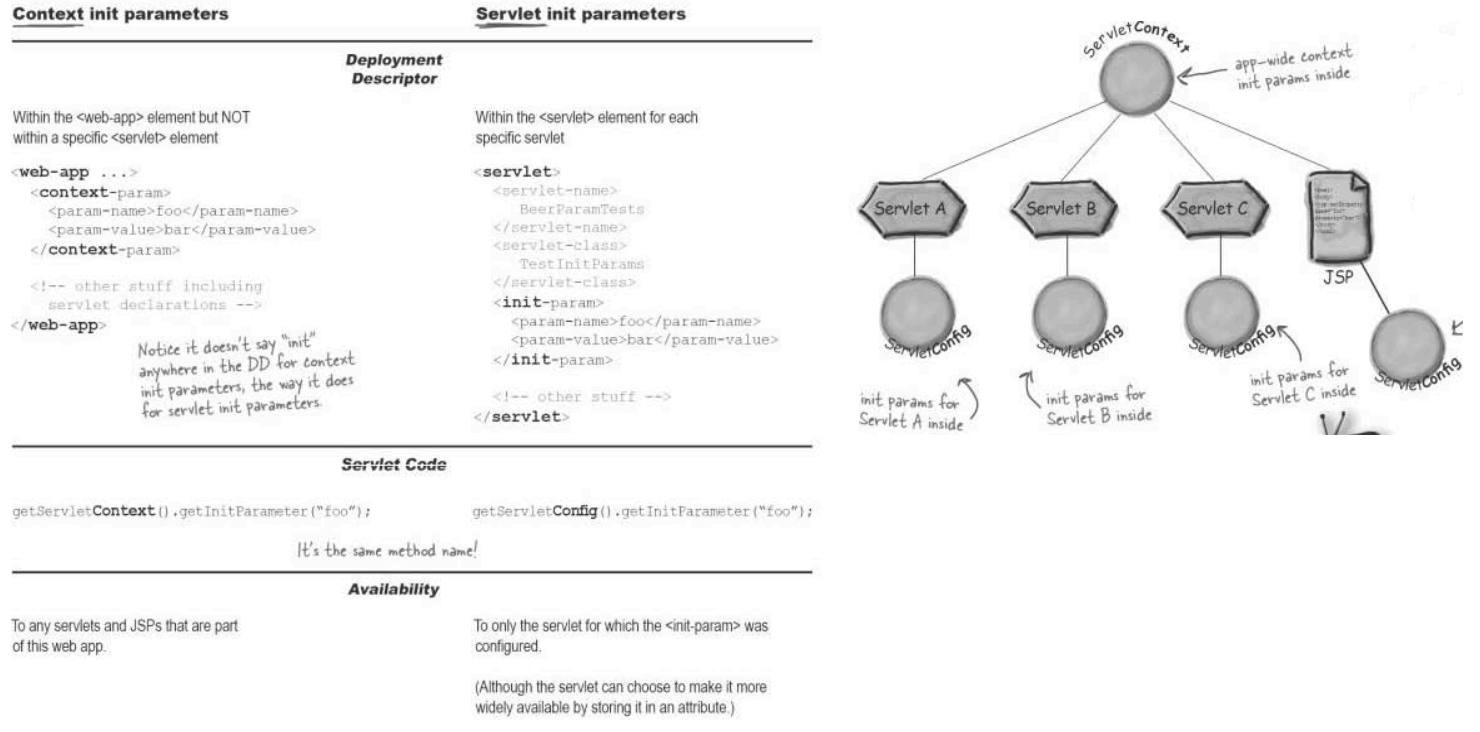
ServletConfig classServletConfig
is a servlet configuration object used by a servlet container to pass information to a servlet during
initialization.
- It has the following methods:
| Method | Description |
|---|---|
| String getInitParameter(String name) | Gets the value of the initialization parameter with the given name. |
| Enumeration<String> getInitParameterNames() | Returns the names of the servlet's initialization parameters as an Enumeration of
String objects, or an empty Enumeration if the servlet has no initialization
parameters.
|
| ServletContext getServletContext() | Returns a reference to the ServletContext in which the caller is executing. Same as
running this.getServletContext |
| String getServletName() | Returns the name of this servlet instance. |
- The problem with using the context-init parameters is that you are only allowed values that are of type String. What if you wanted to do something more involved - like adding an object to your webapp that any servlet/JSP could access? Here we make use of a Listener that reads the value of the context init param from the DD, and using that string value, creates a new object and adds it to the
ServletContext
using setAttribute that is then passed to your web app. Any servlet/jsp can then get that
attribute from the ServletContext object using getAttribute. - This is what you came up with:
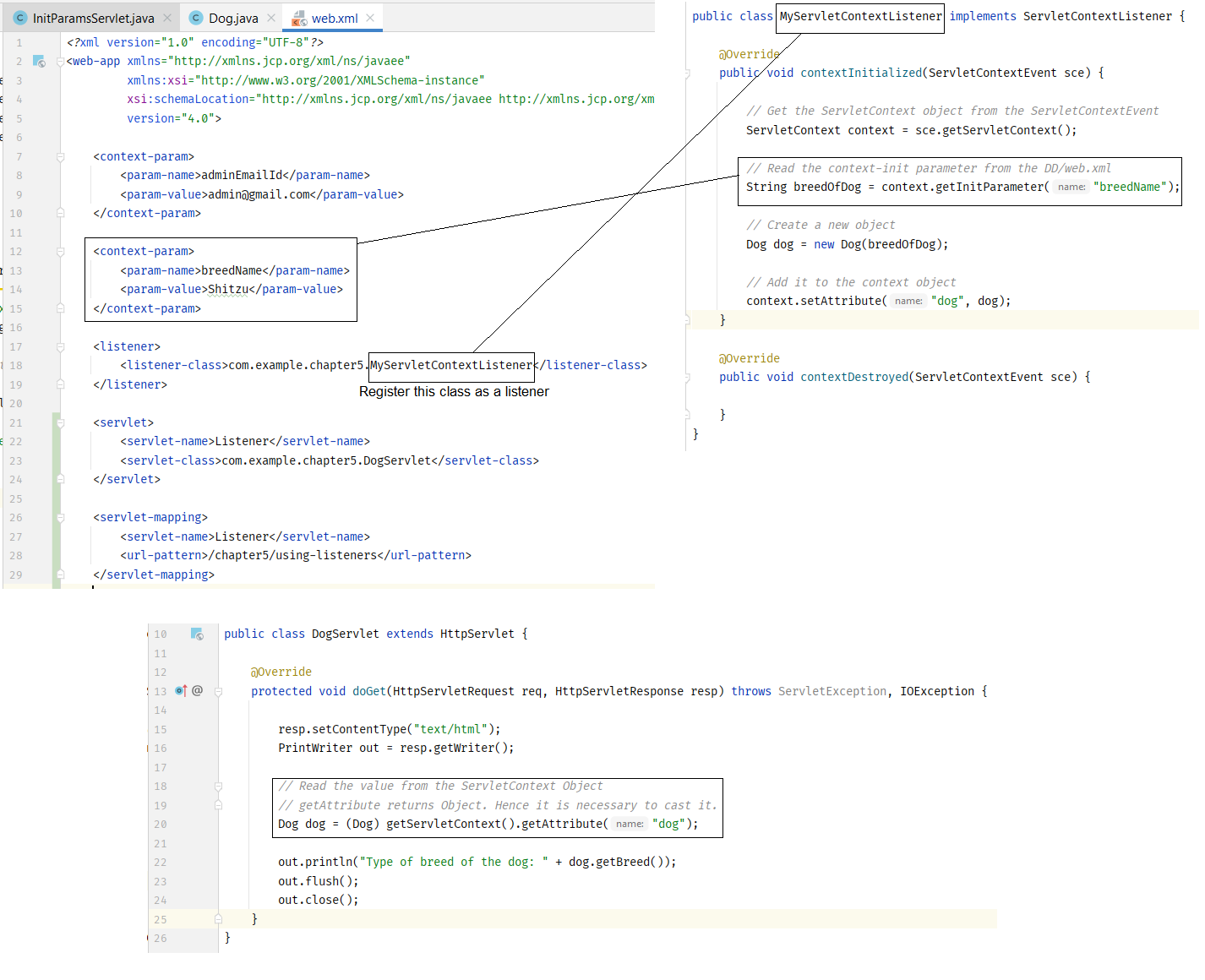
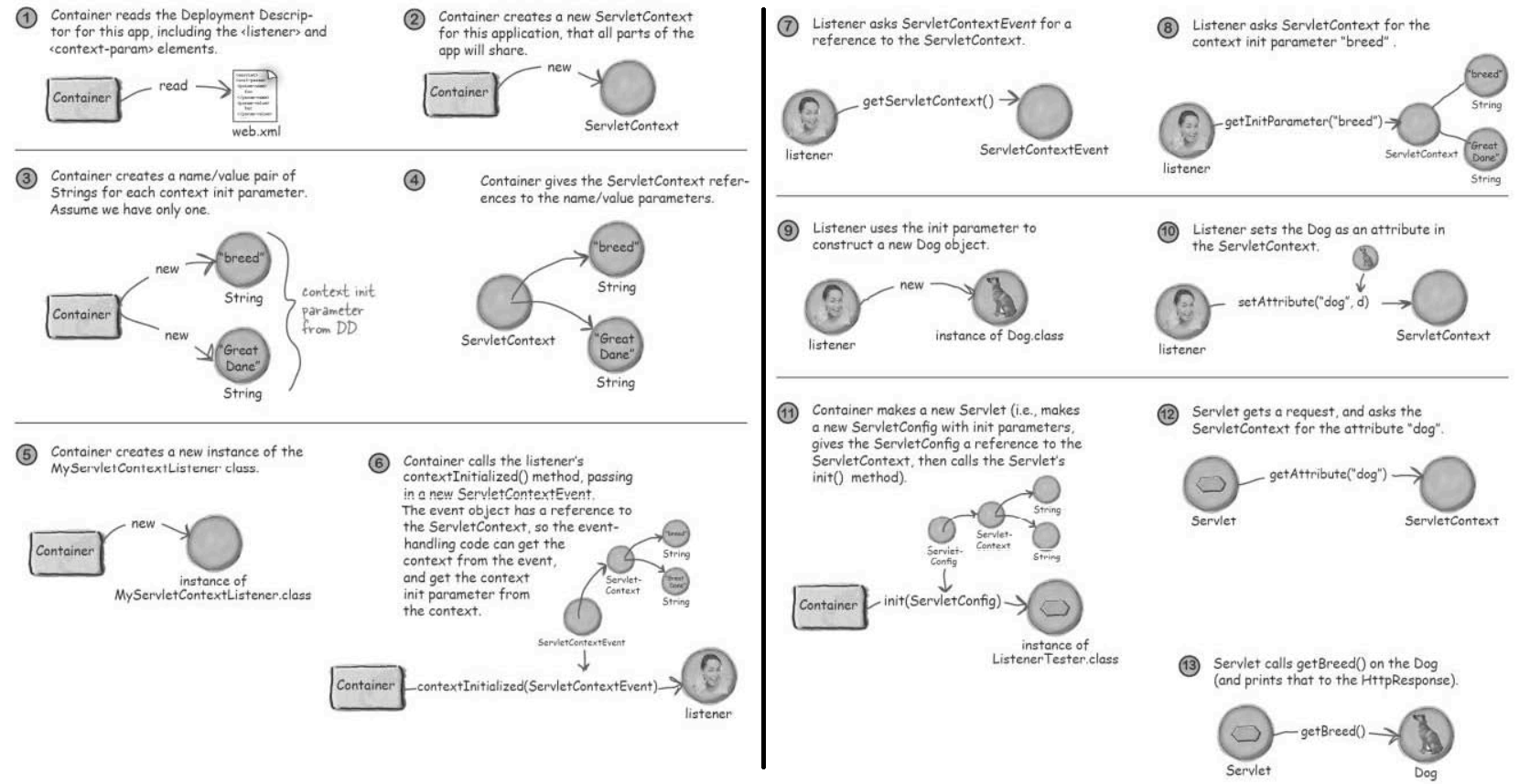
ServletContextListener. Both
contextInitialized and contextDestroyed methods are overridden. I think it is
mainly being used for logging purposes, to kind of try and understand what kind of branch the code is taking
(I guess!). Nothing is being read from the ServletContextEvent.
HttpSessionListener interfaceServletContext,
HttpServletRequest (ServletRequest), or HttpSession
- An attribute is simply a name/value pair (where the name is a String and the value is an object) in a map instance variable.
- In reality, we do not care how it is implemented - all we really care is about the scope in which the attribute exists. In other words, who can see it and how long does it live.
- We use
request.getParameter() to extract request parameters (i.e. data sent by posting a html
form). The request.getParameter() always returns String value and the data comes from client.
The exception to this is ServletContext and the ServletConfig init-parameters
which are string parameters that are configured in web.xml and exist on the server.

ServletContext attribute is an object bound into a context
through the ServletContext.setAttribute()
method and which is available to ALL Servlets (thus JSP) in that context, or to other contexts via the
getContext() method. By definition a context attribute exists locally in the VM where they were
defined. So, they're unavailable on distributed applications.
- Session Attributes: Session attributes are bound to a Session, as a means to provide state to a set of related HTTP requests. Session attributes are available ONLY to those Servlets which join the session. They're also unavailable to different JVMs in distributed scenarios. Objects can be notified when they're bound/unbound to the Session implementing the
HttpSessionBindingListener interface.
- Request Attributes: Request attributes are bound to a specific request object, and they last as far as the request is resolved or while it keeps being dispatched from Servlet to Servlet. They're used more as communication channel between Servlets via the
RequestDispatcher Interface (since you can't add Parameters...) and by the container. Request
attributes are very useful in web apps when you must provide setup information between information providers
and the information presentation layer (a JSP) that is bound to a specific request and need not be available
any longer, which usually happens with sessions without a rigorous control strategy.
- StackOverflow Source
- These 3 attribute scopes are handled by the
ServletContext,
HttpSession, and ServletRequest interfaces. The API methods for these attributes
are the same in every interface:
Object getAttribute(String name)void setAttribute(String name, Object value)void removeAttribute(String name)Enumeration<String> getAttributeNames(String name)
- In order to make them thread-safe, you need an intrinsic lock on the ServletContext object. Every object has an intrinsic lock associated with it. By convention, a thread that needs exclusive and consistent access to an object's fields has to acquire the object's intrinsic lock before accessing them, and then release the intrinsic lock when it's done with them. A thread is said to own the intrinsic lock between the time it has acquired the lock and released the lock. As long as a thread owns an intrinsic lock, no other thread can acquire the same lock. The other thread will block when it attempts to acquire the lock.
- This way everyone accessing the context has to first get the lock on the Context object. This ensures that only one thread is setting and getting the context attribute. But remember that this works only if ALL of the other code that manipulates the same context attribute ALSO synchronizes on the ServletContext. If even part of the code doesn't ask for the lock, then that code is free to hit the context attributes.
//TODO: Why not get a lock just on the variable being changed? Instead of getting a lock on the entire ServletContex?
//i.e. do:
synchronized (this.getServletContext().getAttribute("UserCount")) ?
- Writing Servlet code:
Thread Safety Tips
Why is singlethreadmodel deprecated
- Everything else is subject ot multi-threaded manipulation unless you do something about it.
- Everything else includes:
- Context Scoped Attributes
- Session Scoped Attributes
- Instance Variables in the Servlet
- Static Variables in the Servlet
- Can you make instance variables thread-safe: No. You should avoid using instance variables in your code.
- Then what should you use if you need multiple instances of the Servlet to share something: It's incorrect to say "multiple instances of the Servlet" because there is always just ONE instance of the servlet. One instance. Many threads...
- If you want all the threads to access a value, decide which attribute state makes the most sense and store the value in that attribute. Chances are you can solve the problem in one of two ways:
- Declare the variable as a local variable inside the service method, rather than as an instance variable
- Use an attribute in the most appropriate scope
- So how do we make another part of the component to take over the request -
RequestDispatcher
RequestDispatcher's have only two methods:
forward(ServletRequest request, ServletResponse response)include(ServletRequest request, ServletResponse response)
RequestDispatcher in two ways: from the request or from the context. Regardless
of where you get it, you ahve to tell it the web component ot which you are forwarding the request.
- Use a stateful session enterprise java bean: Make your servlet become a Client to a stateful session bean, and each time a request comes in we locate that Client's stateful bean. Remember that for doing this you hosting provider should have full J2EE server with an EJB Container. Tomcat is just a web container, not a full J2EE container.
- Use a Database: Have your hosting provider communicate with a database, like MySQL. Then all the client's data can be written to or read from the database. The downside is that it is extremely expensive to do this.
-
Use an
HttpSession: We can use anHttpSessionto hold the conversational state over multiple requests - i.e for the entire session with the user.
- The Container solves this problem by assigning a unique
SessionID to each user.
- On the Client's first request, the Container generates a unique session ID and gives it back to the Client with the response. The Client then sends back the session ID with each subsequent request. The Container sees the ID, finds the matching session, and associates the session with the request.
- Attributes bound into a session are available to any other servlets that belong to the same
ServletContext
and handles a request identified as being a part of the same session.
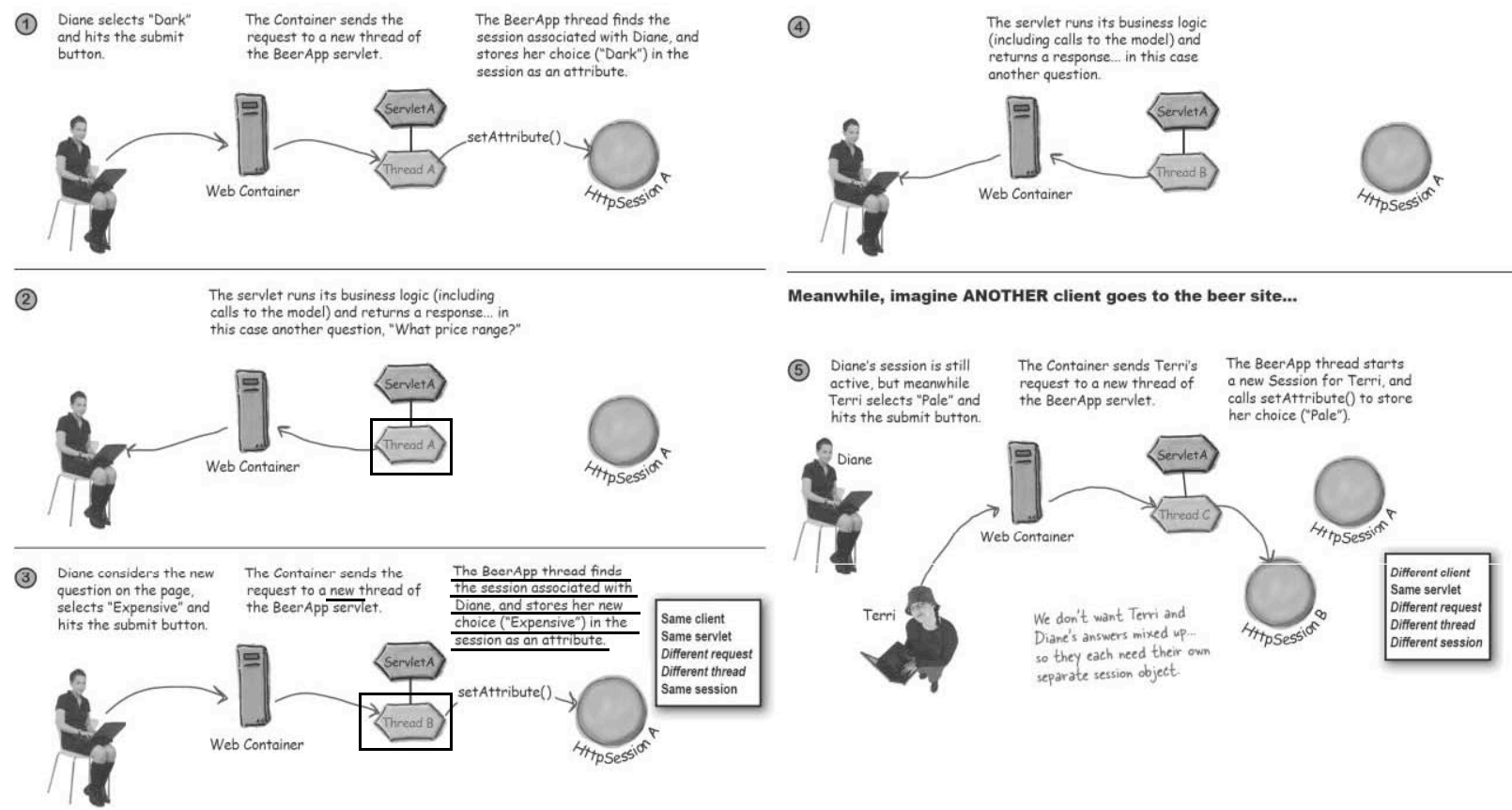
Cookies to do this.
- All you have to do is tell the Container that you want to create or use a Session. The Container takes care of the rest. The Container generates the SessionID, creates a new
Cookie object, stuffs
the SessionID into the Cookie object, sets the Cookie as a part of the response.
On subsequent
requests, the Container gets the SessionID from the Cookie in the request, matches the SessionID
with an existing session, and associates that session with the current request.
- The
HttpSession session = request.getSession() does the following:
if(the request contains the SessionID object)
find the Session matching that ID
else if (there is no SessionID Cookie OR there is no session matching the current SessionID)
create a new session
HttpSession session = request.getSession() method returns a session regardless of
whether there is a
pre-existing session or not. You can check if it is a new session by using session.isNew()
method.
-
HttpSession session = request.getSession(false) will return null if there is no
pre-existing session for the Client. You can use it if you have a scenario in which the servlet wants to use
only a previously created session.
- There are couple of points that you were confused about that need to be clarified:
- You can check the cookies that are stored in the browser on Chrome - Inspect - Application - Cookies
Here you will see the Cookies with the name
JSESSION ID. This is the same id as the sessionId.
While testing, if you see your app behaving abnormally (session seems to be behaving weirdly), first clear
the cookies in your browser (Ctrl + Shift + Del) and then retry. If that does not work, go into your app and
by inspecting elements, manually delete the cookies.
- Note that a sessionId is assigned to you the moment you first log in into the website. In the dummy example that we had, the first page that the user was reaching was a index page. The
doGet method was
activated only when the user clicked a button on the index page to get the form. The point is that, line 4
of the below code will always contain a valid session.
- Check this SO Post explaining things.
- So in order to kill that session, we first call
session.invalidate. Remember that this will
not set the session to null as explained
here in SO. So we get the session again, as on Line 8. This time the Container does not find any
existing sessions and the session variable is in fact null. When we run the code, now, the
if (session == null) block is executed.
- URL rewriting kicks in only if cookies fail and you have explicitly encoded your URLs.
- Read up on the
encodeURL method
- When a Container sees a call to
getSession, and the Container does not have the SessionID
associated with the Client's request, the Container knows that it must attempt to set up a new session with
the Client. At this point the Container does not know whether the Cookies will work or not. Hence for the
first response back to the Client, the Container tries both, Cookies and URL Rewriting.
HttpSession methods- It times out
- You call
invalidate()on the Session object - The application goes down or crashes
a) Setting Session Timeout: There are two ways to set the session timeout
- Setting Session Time out for a specific session: Use this if you want to change the
session-timout value for a particular session instance without affecting the timeout length for any
other sessions in the app.
session.setMaxInactiveInterval(20*60)
Only the session on which you call the method will be affected. Note that the argument to the method is in seconds. - Configuring Session Timeout in the DD: This has the same effect as calling
setMaxInactiveInterval()on every session that is created.
invalidate(): Invalidates this session then unbinds any objects bound to it.
Like we discussed earlier, calling this method will not set the session object to null.
- By default, a Cookie lives only as long as the session. Once the client quits his browser, the cookie disappears. That's how the
JSESSION cookie works. But you can tell a cookie to stay alive even
AFTER the browser shuts down. These types of cookies are known as Persistent Cookies.
- The question is: how does the Container manage the
ServletConfig, ServletContext,
and HttpSession objects in this case.
- Only
HttpSession objects (and their attributes) move from one VM to another.
- There is one
ServletContext per VM. There is one ServletConfig per
Servlet, per VM. But there is only one HttpSession object for a given
SessionId
per web app, regardless of how many VM's the app is distributed across.
- The key point here is that while the other parts of the app are replicated on each node/VM, the session objects (along with the session attributes) are moved.
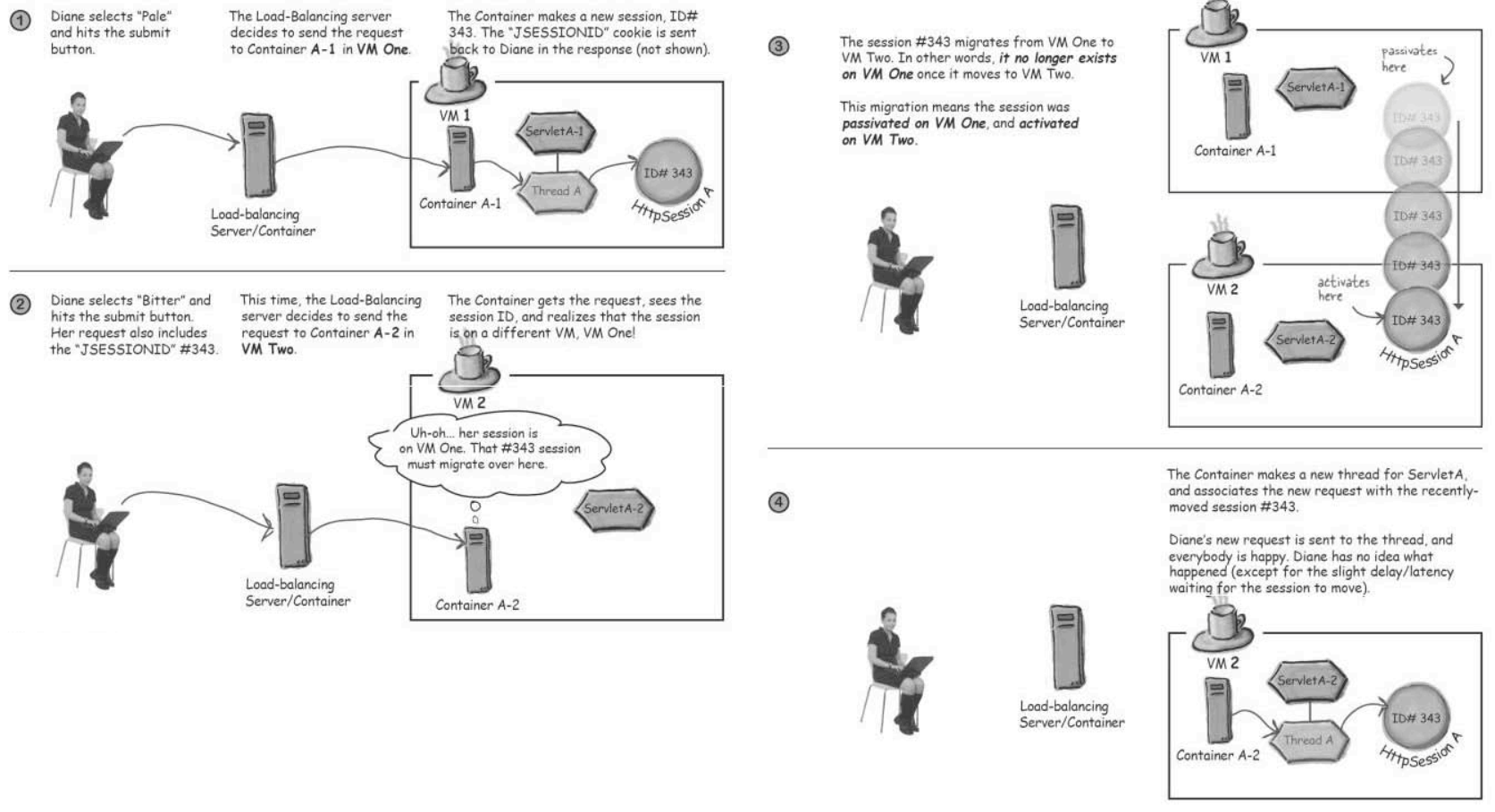
HttpSessionActivationListener
HttpSessionAttributeListener
HttpSessionAttributeListener
service()
method.
- When you deploy a web app witha JSP, the whole translation and compilation step happens only once in the JSP's life. Once it has been translated and compiled, it is just like any other servlet. And just like any other servlet, once that servlet has been loaded and initialized, the only thing that happens at request time is creation or allocation of a thread for the service method. So the above picture is only for the very first request that the container has to handle.
- Directives come in three flavors:
- page
- include
- taglib
- Importing a single package can be done as follows:
<%@ page import = "java.util.List" %>.
Notice that there is no semicolon at the end of the import statement.
- Importing a multiple packages can be done as follows:
<%@ page import = "java.util.List,java.util.Map"%>. Note that packages are separated by
comma and the quotes go around the entire list of packages.
- Scriptlet
<% %>: Between these tags goes the java code that you want to write in the JSP page.
So we can write<% out.println(Counter.getCount()); %>. - Directive
<%@ %>: used for writing import statements, among other things, in the JSP. No semi-colon at the end. - Expression
<%= >: it automatically prints out whatever you put between the tags. This is meant as a replacement forout.printlnin JSP. So, instead of writing, say,<% out.println(Counter.getCount()); %>, we would just write<%= Counter.getCount() %>. Note that the expression does not need a semicolon at the end either. A n expression cannot use a method that does not have a return type, i.e hasvoidas return type because then there won't be anything to print.
out in the above example is passed implicitly to your
JSP page, just in case you want to pass it to some other object that does not have direct access to the
output stream for the response.
- Also note that the code from the JSP is placed inside the
_jspService method that takes as
argument the HttpServletRequest request object. Hence you wan write your JSP assuming that it
is going to be a part of a servlet. This is also an example of "implicit" object. Something that we see in
the next paragraph.
<%! int count = 0;%>.
- Note that this requires a semicolon at the end. JSP declarations are for declaring members of the generated servlet class. This means, both, variables and methods. In other words, anything between the
<%! %> tag is added to the class outside the service method. That means
that you can declare, both, static variables (what?) and methods.
| API | Implicit Object |
|---|---|
| JspWriter | out |
| HttpServletRequest | request |
| HttpServletResponse | response |
| HttpSession | session |
| ServletContext | application |
| ServletConfig | config |
| Throwable | exception |
| PageContext | pageContext |
| Object | page |
- A
pageContext encapsulates the other implicit objects. This way if you give some other helper
object a reference to the PageContext, the helper can use that reference to get all the OTHER implicit
object
and attributes from all the scopes.
| JSP Element | Usage | What is it used for | Usage Example |
|---|---|---|---|
| Scriptlet | <% ;%> |
Used to write Java Code | <% out.println(Counter.getCount()); %> |
| Directive | <%@ %> |
Used for writing import statements | <%@ page import = "java.util.List" %> |
| Expression | <%= %> |
Printing out stuff | <%= Counter.getCount() %> |
| Declaration | <%! ;%> |
Declaring methods and instance variables in the JSP | <%! int count = 0;%> |
| ExpressionLanguages | ${ } |
Invokes Java Code | ${applicationScope.mail} |
| Actions | <jsp: />, <c: /> |
They are 2 types: standarad and other |
|
| Scope | In a Servlet | In a JSP (using implicit objects) |
|---|---|---|
| Application/Context | getServletContext.setAttribute("foo", barObject) |
application.setAttribute("foo", barObject) |
| Request | request.setAttribute("foo", barObject) |
request.setAttribute("foo", barObject) |
| Session | request.getSession().setAttribute("foo", barObject) |
session.setAttribute("foo", barObject) |
| Page | Does not apply |
pageContext.setAttribute("foo", barObject) |
//Your comment: in a scriptlet or a declaration. However, outside of this the string "//" would just be parsed like normal HTML comment and you would see your comment printed on the page<!-- HTML Comment -->: Use this if you want the comments to stay as a part of the HTML response to the Client<%-- JSP Comment --%>: Comments will be hidden. They are stripped off when the JSP is converted into Java.
- Instead we make use of Expression Language or EL. The purpose of EL is to offer a simeple way to invoke Java code - but the code itself belongs somewhere else. That means in a regular old Java class that's either a JavaBean, a class with static methods, or something called a Taghandler.
- In other words you do not write method code into your JSP. You write the Java methods somewhere else and call it using EL.
- You can use
<scripting-invalid> true </scripting-invalid> to disable scripting
elements for ALL JSPs. There is a specific format for this. Refer text.
- Once you've downloaded and extracted a Tomcat binary, you can start Tomcat by running the startup.bat (on Windows) or the startup.sh file (on Unix/Linux/Mac OS). Both files reside under the bin directory of Tomcat's installation directory. By default, Tomcat runs on port 8080, so you can test Tomcat by directing your browser to this address: http://localhost:8080
Context can be found here on the Tomcat docs. Good read. Go
through the Host section under Containers as well. That is relevant too. - To deploy a servlet/JSP application to Tomcat, you need to define a Tomcat context either explicitly or implicitly. Each Tomcat context represents a web application in Tomcat.
- There are several ways of defining a Tomcat context explicitly, including:
a) Creating an XML file in Tomcat's conf/Catalina/localhost directory: If you decide to create an XML file for each context, the file name is important as the context path is derived from it. For example, if you place a commerce.xml file in the conf/Catalina/localhost directory, the context path of your application will be commerce and a resource can be invoked using this URL:
http://localhost:8080/commerce/resourceName. - A context file must contain a Context element as its root element. Most of the times the element does not have child elements and is the only element in the file. For example, here is an example context file, consisting of a single line:
<Context docBase="C:/apps/commerce" reloadable="true"/>. The only required attribute
is docBase, which specifies the location of the application. The reloadable attribute is optional, but if it is present and its value is set to true, Tomcat will monitor the
application for any addition, deletion, or update of a Java class file and other resources. When such a change is detected, Tomcat will reload the application. Setting
reloadable to true is recommended during development but not in production. When you add a context file to the specified directory, Tomcat will automatically load the
application. When you delete it, Tomcat will unload the application. b) Adding a Context element in Tomcat's conf/server.xml file: Another way of defining a context is by adding a Context element in the conf/server.xml file. To do this, open the file and create a Context element under the Host element. Unlike the previous method, defining a context here requires that you specify the path attribute for your context path.
- We looked at two ways to deploy an application explicitly, but we can also deploy it implicitly. You can do it by by copying a war file or the whole application to Tomcat's webapps directory.
- Servlets are Java classes that run on a servlet container. A servlet container or servlet engine is like a web server but has the ability to generate dynamic contents, not only serve static resources.
- A servlet application runs inside a servlet container and cannot run on its own. A servlet container passes requests from the user to the servlet application and responses from the servlet application back to the user. Most servlet applications include at least several JSP pages. As such, it's more appropriate to use the term "servlet/JSP application" to refer to a Java web application than to leave JSP out.
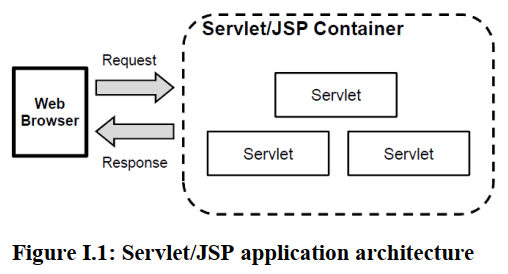
- A servlet/JSP container is a special web server that can process servlets as well as serve static contents. In the past, people were more comfortable running a servlet/JSP container as a module of an HTTP server such as the Apache HTTP Server because an HTTP server was considered more robust than a servlet/JSP container. In this scenario the servlet/JSP container would be tasked with generating dynamic contents and the HTTP server with serving static resources. Today servlet/JSP containers are considered mature and widely deployed without an HTTP server. Apache Tomcat and Jetty are the most popular servlet/JSP containers and are free and open-source.
- Servlet and JSP are two of a multitude of technologies defined in the Java Enterprise Edition (EE). Other Java EE technologies include Java Message Service (JMS), Enterprise JavaBeans (EJB), JavaServer Faces (JSF), and Java Persistence. The complete list of technologies in the Java EE version 6 (the current version) can be found here.
- To run a Java EE application, you need a Java EE container, such as GlassFish, JBoss, Oracle WebLogic, and IBM WebSphere. You can deploy a servlet/JSP application in a Java EE container, but a servlet/JSP container is sufficient and is more lightweight than a Java EE container. Tomcat and Jetty are not Java EE containers, so they cannot run EJB or JMS.
http://google.com/index.html. The first part of the URLs is http, which identifies the protocol. Not all
URLs use HTTP. For instance, these two URLs are valid even though they are not HTTP-based URLs: mailto:joe@example.com,
ftp://marketing@ftp.example.org. - In general, a URL has this format:
protocol://[host.]domain[:port][/context][/resource][?query string] or
protocol://IP address[:port][/context][/resource][?query string]. The parts in square brackets are optional. - Both of these are valid URLs: http://yahoo.ca or http://192.168.1.9. You can find the IP address by doing
ping google.com. For an IPv6 address, you need to
wrap it inside a square bracket as explained here. Note that you need to have IPv6 working on your OS, and every device in the
path to the destination (including proxy servers if you use one). - Also note this as explained here: An IP address is not necessarily unique to a specific Web site. For many years Web providers have been using the HTTP 1.1 Host header to distinguish web sites and serve multiple web sites from a single IP address. Your web browser sends a Host header to the Web server telling it the domain name of the site you requested, and the server responds with the correct page. If you give an IP address only, the server has no way to determine which site (among the possibly many behind the IP address) you want. In this situation some sites return a generic page, and some return an error code to the browser.
- The host part may be present and identify a totally different location on the Internet or an intranet. For instance, http://yahoo.com (no host) brings you to a different location than http://mail.yahoo.com (with a host). Over the years www has been the most popular host name and become the default. Normally, http://www.domainName is mapped to http://domainName.
- 80 is the default port of HTTP. Therefore, if a web server runs on port 80, you don't need the port number to reach the server. 443 is the default port for HTTPS. Sometimes, however, a web server doesn't run on port 80 and you need to type the port number. For example, Tomcat by default runs on port 8080, so you need to supply the port number:
http://localhost:8080.
localhost is a reserved name typically used to refer to the local computer, i.e. the same computer the web browser is running on. - We also have absolute and relative URLs. In your browser's address bar, a URL doesn't have any context, so you must provide a full (or absolute) URL, like the ones we saw above. You don't need to include the protocol (the browser uses HTTP by default) or the port (which is only required when the targeted Web server is using some unusual port), but all the other parts of the URL are necessary. But when a URL is used within a document, such as in an HTML page, things are a bit different. Because the browser already has the document's own URL, it can use this information to fill in the missing parts of any URL available inside that document. We can differentiate between an absolute URL and a relative URL by looking only at the path part of the URL. If the path part of the URL starts with the
/ character, the browser will fetch that resource
from the top root of the server, without reference to the context given by the current document. This is the most common use case for an absolute URL within an HTML document.
The browser will use the same protocol and the same domain name as the one used to load the document hosting that URL. Look at examples here on MDN. - The context part in a URL refers to the application name, but this is also optional. A web server can run multiple contexts (applications) and one of them can be configured to be the default context. To request a resource in the default context, you skip the context part in a URL. A context can have one or more default resources (ordinarily index.html or index.htm or default.htm). A URL without a resource name is considered to identify a default resource. Of course, if more than one default resource exists in a context, the one with the highest priority will always be returned when a client does not specify a resource name.
- After a resource name comes one or more query string. A query string is a key/value pair that can be passed to the server to be processed.
a) Method-Uniform Resource Identifier (URI)-Protocol/Version
b) Request headers
c) Entity body
- This is what a sample HTTP request looks like:
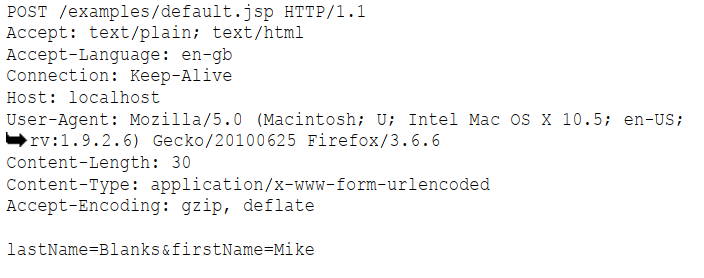
/ . - In an HTTP request, the request header contains useful information about the client environment and the entity body of the request. For instance, it may contain the language the browser is set for, the length of the entity body, and so on. Each header is separated by a carriage return/linefeed (CRLF) sequence. Between the headers and the entity body is a blank line (CRLF) that is important to the HTTP request format. The CRLF tells the HTTP server where the entity body begins. In some Internet programming books, this CRLF is considered the fourth component of an HTTP request. In the previous HTTP request, the entity body is simply the following line: lastName=Blanks&firstName=Mike
a) Protocol-Status code-Description
b) Response headers
c) Entity body
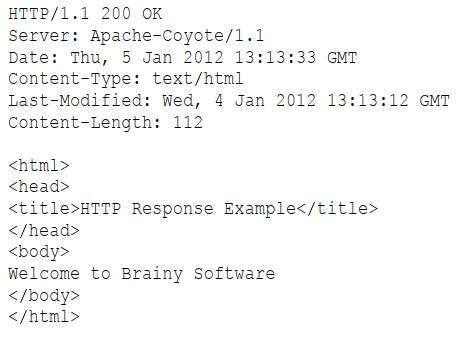
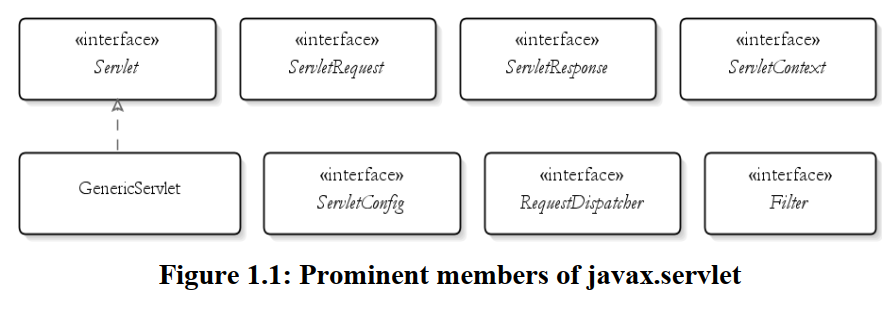
Servlet, an interface that all servlet classes must implement either directly or indirectly. - The
Servlet interface defines a contract between a servlet and the servlet container. The contract boils down to the promise by the servlet container to load
the servlet class into memory and call specific methods on the servlet instance. There can only be one instance for each servlet type in an application. - A user request causes the servlet container to call a servlet's
service method, passing an instance of ServletRequest and an instance of
ServletResponse. The ServletRequest encapsulates the current HTTP request so that servlet developers do not have to parse and manipulate raw HTTP
data. The ServletResponse represents the HTTP response for the current user and makes it easy to send response back to the user. - For each application the servlet container also creates an instance of
ServletContext. This object encapsulates the environment details of the context
(application). There is only one ServletContext for each context. For each servlet instance, there is also a ServletConfig that encapsulates the
servlet configuration.
Servlet interface1) The servlet is constructed, then initialized with the
init method. 2) Any calls from clients to the
service method are handled. 3) The servlet is taken out of service, then destroyed with the
destroy method, then garbage collected and finalized. - An important point to note is thread safety. A servlet instance is shared by all users in an application, so class-level variables are not recommended, unless they are read-only or members of the java.util.concurrent.atomic package.
- The
Servlet interface defines the following 5 methods here on the Oracle
site: a)
void init(ServletConfig config) throws ServletException: The servlet container invokes this method the first time the servlet is requested. This method is not
called at subsequent requests. You use this method to write initialization code. When invoking this method, the servlet container passes a ServletConfig.
Normally, you will assign the ServletConfig to a class level variable so that this object can be used from other points in the servlet class. b)
void service(ServletRequest req, ServletResponse res) throws ServletException, IOException : The servlet container invokes this method each time the
servlet is requested. You write the code that the servlet is supposed to do here. The first time the servlet is requested, the servlet container calls the init
method and the service method. For subsequent requests, only service is invoked. c)
void destroy() : The servlet container invokes this method when the servlet is about to be destroyed. This occurs when the application is unloaded or when the
servlet container is being shut down. Normally, you write clean-up code in this method d)
String getServletInfo() : This method returns the description of the servlet. You can return any string that might be useful or even null. e)
ServletConfig getServletConfig(): This method returns the ServletConfig passed by the servlet container to the init method. However, in order for
getServletConfig to return a non-null value, you must have assigned the ServletConfig passed to the init method to a class level
variable.
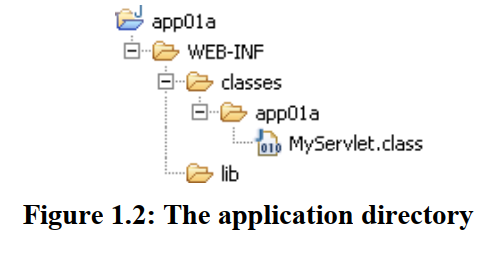
a)
classes
: Your servlet classes and other Java classes must reside here. The directories under classes reflect the class package. In Figure 1.2 there is one class deployed, app01a.MyServlet.b)
lib
: Deploy jar files required by your servlet application here. The Servlet API jar file does not need to be deployed here because the servlet container already has a copy of it. In this application, the lib directory is empty. An empty lib directory may be deleted.- Any resource you put under the application directory is directly accessible to the user by typing the URL to the resource. If you want to include a resource that can be accessed by a servlet but not accessible to the user, put it under WEB-INF.
- The directory name is also important because this also appears in the URL to your servlet. See the URL that we are using to access the site below. In Intellij, this project name forms a part of the "Application Context". Go to Run - Edit Configurations - Deployment. There you will see the Application Context field. In your webapp, when you do
servletRequest.getContextPath(), it is the value of this "Application Context" that will be returned. - The recommended method for deploying a servlet/JSP application is to deploy it as a war file. A war file is a jar file with war extension. You can create a war file using the jar program that comes with the JDK or tools like WinZip. You can then copy the war file to Tomcat's webapps directory. When you start or restart Tomcat, Tomcat will extract the war file automatically. Deployment as a war file will work in all servlet containers.
- Note that Servlet 3.0 onwards, they have started using the
@WebServlet(name = "WelcomeServlet", urlPatterns = {"/welcome"}) annotation instead of writing this
configuration in the web.xml file. You would access this link by doing http://localhost:8080/app01a/welcome.
- For every HTTP request, the servlet container creates an instance of
ServletRequest and passes it to the servlet's service method. The
ServletRequest encapsulates information about the request. -
getParameter(String name) is the most frequently used method in ServletRequest. A common use of this method is to return the value of an HTML form field.
getParameter can also be used to get the value of a query string. For example, if a servlet is invoked using this URI
http://domain/context/servletName?id=123, you can retrieve the value of id from inside your servlet using this statement:
String id = request.getParameter("id");. Note that getParameter returns null if the parameter does not exist.
- Prior to invoking a servlet's
service method, the servlet container creates a ServletResponse and pass it as the second argument to the service
method. The ServletResponse hides the complexity of sending response to the browser. - One of the methods defined in
ServletResponse is the getWriter method, which returns a java.io.PrintWriter that can send text to the
client. There is also another method that you can use to send output to the browser: getOutputStream. However, this method is for sending binary data. - Before sending any HTML tag, you should set the content type of the response by calling the
setContentType method, passing "text/html" as an argument. This is
how you tell the browser that the content type is HTML. Most browsers by default render a response as HTML in the absence of a content type.
- The servlet container passes a
ServletConfig to the servlet's init method when the servlet container initializes the servlet. The
ServletConfig encapsulates configuration information that you can pass to a servlet through @WebServlet or the deployment descriptor. Every piece of
information so passed is called an initial parameter. An initial parameter has two components: key and value. - To retrieve the value of an initial parameter from inside a servlet, call the
getInitParameter method on the ServletConfig passed by the servlet
container to the servlet's init method.
@WebServlet since the deployment descriptor is a text file and you can edit it without recompiling the servlet class. The deployment
descriptor also allows you to override values specified in a servlet annotation.
- The
ServletContext represents the servlet application. There is only one context per web application. In a distributed environment where an application is
deployed simultaneously to multiple containers, there is one ServletContext object per Java Virtual Machine. In this situation, the context cannot be used as a
location to share global information (because the information won't be truly global). Use an external resource like a database instead. - The
ServletContext is there so that you can share information that can be accessed from all resources in the application and to enable dynamic registration of
web objects. The former is done by storing objects in an internal Map within the ServletContext. Objects stored in ServletContext are
called attributes.
- In the above example, we saw how implementing the
Servlet interface caused us to implement all the 5 methods defined on the interface even if we did not have
the need for all of them. In its place, we can extend the GenericServlet which provides default implementations of the methods except the service
method. -
GenericServlet implements the Servlet and ServletConfig interfaces. GenericServlet may be directly extended by a
servlet, although it's more common to extend a protocol-specific subclass such as HttpServlet. It also assigns the ServletConfig in the
init method to a class level variable so that it can be retrieved by calling getServletConfig.
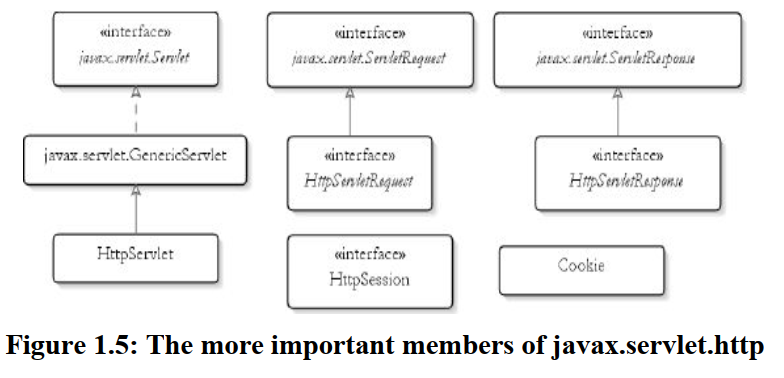
- The
HttpServlet class extends the GenericServlet class. The HttpServletRequest interface extends ServletRequest and
HttpServletResponse extends ServletResponse.HttpServlet overrides the service method in GenericServlet and
adds another service method with the following signature:
protected void service(HttpServletRequest req, HttpServletResponse resp) throws ServletException, IOException. - To summarize, there are two features in
HttpServlet that you do not find in GenericServlet: a) Instead of the
service method, you will override doGet, doPost, or both of them. In rare cases, you will also override any of these
methods: doHead, doPut, doTrace, doOptions, doDelete. b) You will work with
HttpServletRequest and HttpServletResponse, instead of ServletRequest and ServletResponse. -
HttpServletRequest represents the servlet request in the HTTP environment. It extends the ServletRequest interface and adds several methods. Some
methods added are as follows: a)
String getContextPath(): Returns the portion of the request URI that indicates the context of the request. b)
Cookie[] getCookies(): Returns an array containing all the Cookie objects the client sent with this request. This method returns null if no
cookies were sent. c)
String getHeader(String name): Returns the value of the specified request header as a String. If the request did not include a header of the specified name,
this method returns null. If there are multiple headers with the same name, this method returns the first header in the request. The header name is case-insensitive. You can
use this method with any request header. d)
String getMethod(): Returns the name of the HTTP method with which this request was made, for example, GET, POST, or PUT. e)
String getQueryString(): Returns the query string that is contained in the request URL after the path. This method returns null if the URL does not have a
query string. For instance, if this is the URL: http://localhost:8080/ServletsTutorial/QueryStringExample?firstName=Java&lastName=InterviewPoint, then the value
returned by this method will be firstName=Java&lastName=InterviewPoint. f)
HttpSession getSession(): Returns the current session associated with this request, or if the request does not have a session, creates one. g)
HttpSession getSession(boolean create): Returns the current HttpSession associated with this request or, if there is no current session and
create is true, returns a new session. If create is false and the request has no valid HttpSession, this method returns null.
- Extends the
ServletResponse interface to provide HTTP-specific functionality in sending a response. For example, it has methods to access HTTP headers and
cookies. Here are some of the methods defined in it: a)
void addCookie(Cookie cookie): Adds the specified cookie to the response. This method can be called multiple times to set more than one cookie. b)
void addHeader(String name, String value): Adds a response header with the given name and value. This method allows response headers to have multiple values.
c)
void sendRedirect(String location): Sends a temporary redirect response to the client using the specified redirect location URL and clears the buffer. The
buffer will be replaced with the data set by this method. Calling this method sets the status code to SC_FOUND 302 (Found). This method can accept relative URLs; the servlet
container must convert the relative URL to an absolute URL before sending the response to the client. If the location is relative without a leading '/' the container
interprets it as relative to the current request URI. If the location is relative with a leading '/' the container interprets it as relative to the servlet container root. If
the location is relative with two leading '/' the container interprets it as a network-path reference.
ServletRequest.getParameter that takes an input
field name never returns null. - Select: An HTML select element also sends a string to the server. If none of the options in the select element is selected, the value of the option that is displayed is sent. A multiple-value select element (a select element that allows multiple selection and is indicated by
<select multiple>) sends a string array and has to be handled by ServletRequest.getParameterValues(). - Checkbox: A checkbox is a bit extraordinary. A checked checkbox sends the string "on" to the server. An unchecked checkbox sends nothing to the server and
ServletRequest.getParameter(fieldName) returns null. Note that by "nothing" we
mean that there will be no parameter in the HttpServletRequest that will correspond to the name attribute of the checkbox. Hence, doing
ServletRequest.getParameter(fieldName) returns null.
- Radio Buttons: Radio buttons send the value of the selected button to the server. If
none of the buttons is selected, nothing is sent to the server and ServletRequest.getParameter(fieldName) returns null. Similar to the above case, by "nothing is
sent to the server", we mean that there will be no parameter in the HttpServletRequest that will correspond to the name attribute of the radio button.
- If a form contains multiple input elements with the same name, all values will be submitted and you have to use
ServletRequest.getParameterValues() to
retrieve them. ServletRequest.getParameter() will only return the last value. - Below is the form that we are discussing in the above example:
- Another SO Question: Stop data inserting into a database twice and Preventing form resubmission on the same topic.